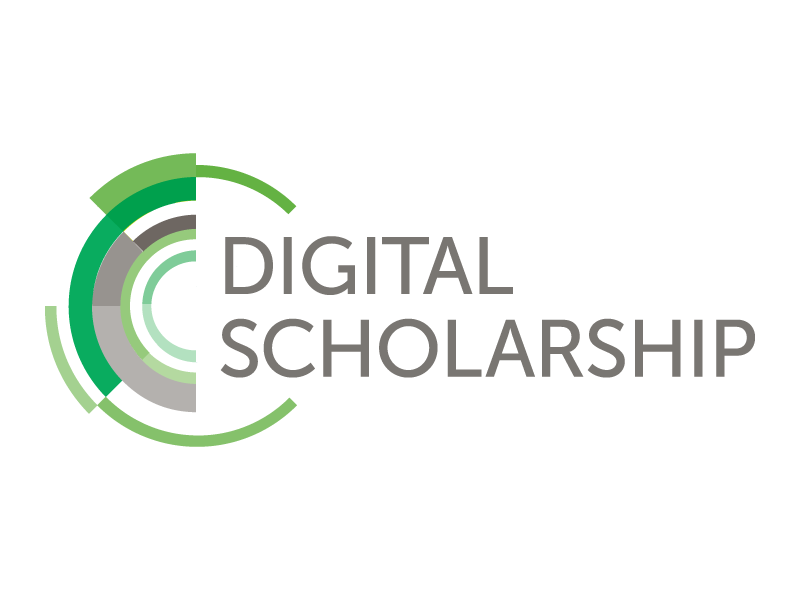
Digital Scholarship at UNT
Share the Digital Scholarship projects you’ve been working on! The Digital Scholarship Workgroup at the UNT Libraries would like to invite you to participate in an important survey on digital scholarship resources, tools, and services. Information about the Workgroup and the survey are below. Please consider sharing your thoughts with us to help us improve our services to the entire UNT community. Survey Link: http://bit.ly/digsch18 About this survey: The Digital Scholarship Workgroup at the UNT Libraries gathers and shares information on digital scholarship activities, resources, and services within and beyond the UNT community. We use this information to better inform the Libraries’ own activities and determine the needs and interests of the communities we serve, including the faculty, staff, and students of UNT, as well as the larger public. This survey will ask about your experience with digital scholarship. For the purposes of this survey, we define “digital scholarship” as: “any research that is presented with, created by, or about digital tools or culture.” Participation in digital scholarship may include the use of digital tools or platforms for the purposes of research, teaching, or dissemination of scholarly work, the creation of new digital technology, or scholarship about the effect of digital tools on society. Participation in this survey is voluntary. All information provided will be kept confidential and used only for internal assessment purposes. Demographic information is optional, but will help us assess the needs of particular populations. You must be age 18 or older to participate in this survey. This survey takes approximately 12 minutes to complete. research_support_services_in_the_news
Posted:
11/27/2018
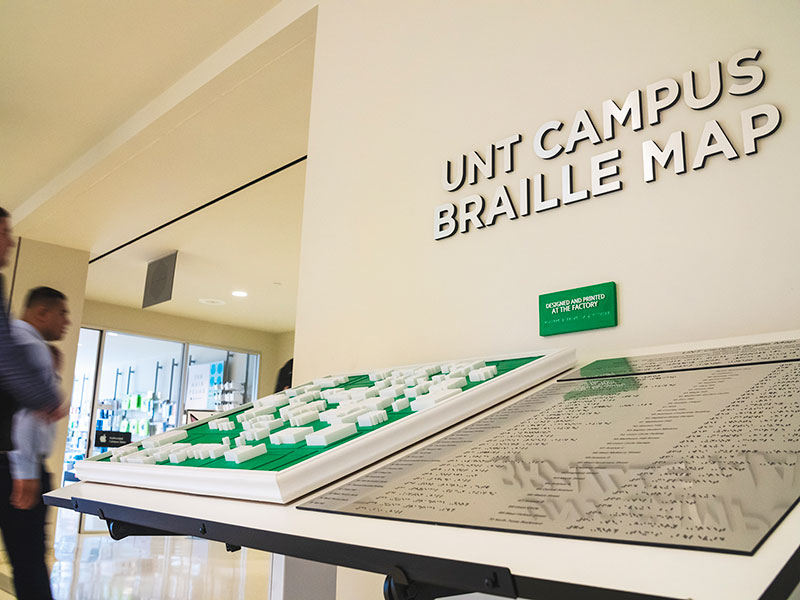
Maker-Tech creates campus braille map in The Factory for University Union
An enterprising student spent her summer hard at work in The Factory creating a new addition to UNT that will benefit the visually impaired members of the campus community for years to come. An enterprising student spent her summer hard at work in The Factory creating a new addition to UNT that will benefit the visually impaired members of the campus community for years to come. In May, The Factory was asked by former Student Government Association (SGA) President Barrett Cole to create a map of the UNT Campus that could be displayed in the University Union. The idea was the map would be tailored towards visually impaired students or visitors, and The Factory’s 3D printing capabilities could handle the braille required for the task. The Factory manager Judy Hunter tasked one of The Factory’s Maker-techs, UNT junior Jordan Barrett, with the project, which called for 54 3D campus buildings on a displayable map with braille labels and a braille key. Barrett came to UNT in 2016 after serving six years in the U.S. Navy. Her background with soldering as an electronics technician while stationed in Hawaii helped her find a home in The Factory. But 3D modeling was a whole new process for Barrett. She would also have to train herself in all kinds of different computer programs — from Adobe Illustrator to Blender to Meshmixer. “It was a lot of trial and error,” Barrett said. The design process took a month. After downloading a map of campus from the UNT website, Barrett traced the map in Illustrator before then lifting it into 3D in Blender. Each of these programs is available in The Factory. The most crucial step, braille, was next. Barrett took time to learn the best practices of braille, specifically braille signage. How much braille could fit on the buildings? Barrett originally wanted to label the street names in braille but found there wasn’t enough room. Instead, Barrett 3D modeled indents for the streets on the map so streets could be distinguished from the rest of the map’s surface. All of these intricacies made Barrett appreciate how difficult life is for the visually impaired. “I can’t imagine how people come up to this map and think, ‘Okay, let me somehow navigate my way from here to this building,’” Barrett said. “How do you know where the steps [on campus] are? It can be so dangerous. “I think the map is a great reference [for the visually impaired] to know where they are on campus,” Barrett says. “But it also helps those who aren’t visually impaired understand what those who are have to go through. [Then they] can brainstorm more ways to make this campus more inclusive.” While Barrett did the 3D modeling design, the factory maker-tech team also assisted in printing and preparing the project for display. That step of the project ran into some roadblocks because the Factory had not taken on a project like this before. “We’re working on technology that can fail, right?” Barrett said. “So there was so many trials and errors because we’ve never done this before. We wanted to do it in two colors, so we had a dual extruder printer. But it came out really bad [at first], so we had to take the time to figure out the correct settings.” The map size was three feet by three feet, but The Factory’s printer was smaller, so the process took time. Then there was bad luck to deal with. At one point, the map looked like it was made of spider-webs. “We had issues,” Barrett said of the printing process. “It was not sticking to the bed and it was warping. Sometimes the print would fail because the design was just a little flawed.” The map was finally unveiled after months of work on Nov. 7. Barrett’s work on the campus map is just another example of how she is drawn to helping people after her military service. She aspires to work in cybersecurity and computer forensics after college. “Once you’ve done something much greater than you, it’s hard to come back and just do a nine-to-five job,” Barrett said. “What am I serving right now? So I want to end up doing something that can help someone.” The braille map is located just outside the Corner store near the front entrance to the Union. You can read more about Barrett and the braille map project here. facilities_operations_in_the_news
Posted:
11/15/2018

Image From The Portal To Texas History Featured In Mural
The Portal to Texas History has left its mark on a new mural in downtown Dallas. The Portal to Texas History has left its mark on a new mural in downtown Dallas. Wells Fargo & Company unveiled the latest addition to their Community Mural program on October 28 with a mural at their branch on the 2000 block of Greenville Avenue. The mural features images of the Hockaday School, the Arcadia Theater, Fair Park and the Dallas train depot. Pictures of local residents also overlay the mural’s background – a reconstruction of what that early Greenville block looked like. One of those local residents is the subject of a Rescuing Texas History photo from The Portal To Texas History: a portrait of a young woman wearing a dark fur dress and standing in front of a painted backdrop. Wells Fargo obtained the image with permission from The Private Collection of TB Willis, one of The Portal to Texas History’s partners. TB Willis purchased the photo and a collection of photographs of African Americans from an estate in Dallas, Texas. In addition to the collection of African-American photographs, The Private Collection of TB Willis consists of historical photographs of World War I military training base Camp MacArthur, church photos, buildings across Texas and family photo albums that include Willis family members and extended relatives who settled in Waco, Texas in the 19th century. Wells Fargo contacted the Portal to Texas History for permission to use the photo in their mural on Lower Greenville. Because The Portal does not own any of the images it provides, Mr. Willis himself granted permission for the photo to be used. The image of the young woman is the only mural image obtained from The Portal to Texas History for this particular mural, the 26th that Wells Fargo has created in Dallas alone. Other photographs from The Portal To Texas History adorn some of these local murals. Wells Fargo’s mural program has installed 361 unique murals across Texas. The latest mural on Lower Greenville can be seen at Wells Fargo Bank at 1931 Greenville Avenue, Dallas, TX 75206. digital_libraries_in_the_news
Posted:
11/08/2018
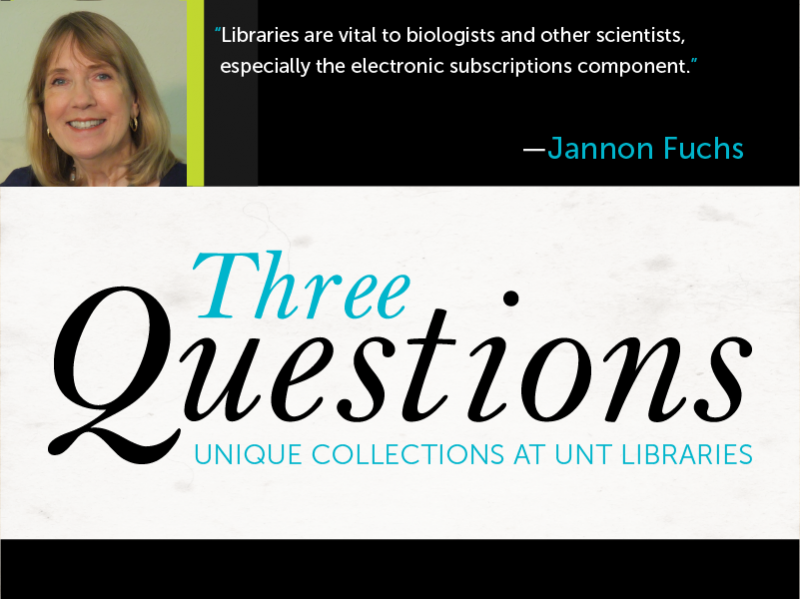
Three Questions with Jannon Fuchs
Dr. Jannon Fuchs is a professor in the Department of Biological Sciences at The University of North Texas. Her research interests include developmental neuroscience with a focus on primary cilia in the birth and survival of cells in the nervous system. Three Questions is an initiative to share the value that our faculty, students, and others in the UNT community derive from using The Portal to Texas History at UNT Libraries. 1. How important are Unique Collections in your teaching, learning or research? 2. How have Unique Collections changed the way you approach your research, teaching or learning? 3. What do you want others to know about your research, teaching or learning? Libraries are vital to biologists and other scientists, especially the electronic subscriptions component. I access electronic journals and/or the database Qinsight several times a week for my neuroscience learning, research, and teaching. Many of the students in my lab (I would like to say all…) find these to be essential resources which are useful on a weekly to daily basis. We use electronic journals through the UNT library so that we can keep up with the latest on topics and methods that impact our research. Biology is extremely diverse yet highly integrated, and the literature is expanding exponentially. Biologists’ universal complaint is that there isn’t enough time for the monumental task of “keeping up with the literature.” For biologists who fall too far behind, the prospect for writing fundable grant proposals is dismal. I remember too well the 1960s, ‘70s, and early ‘80s, when computerized articles and databases were but a dream. We searched the library’s shelves and paged through the latest journal issues. I took notes on a 3X5 card for each article I read, and filed cards and articles by subject and author. On Tuesdays the library would receive the latest issue of Current Contents for Biology & Medicine. It contained the table of contents of all journals, listed by subtopic. About half of the journals we needed were not in the library, so we sent our postcards to request reprints. Some authors sent reprints only to people at prestigious universities in the U.S. As authors, we purchased stacks of glossy reprints (black-and-white, of course), and when we got postcard requests, we addressed envelopes, figured out postage, and proudly stuffed the mailbox. I have many reprints left over, so if you would like some, please send me a postcard. Yes, we have come a long way. Today, the literature is much more vast–and so is the repertoire we are expected to process. It is the age of burgeoning information. Now what we need are innovations to streamline how articles are reviewed and published, and to facilitate how we obtain, extract, and synthesize pertinent information. Not everything has come up roses. Although journals are now online, and many are exclusively online, electronic subscriptions can be prohibitively expensive for libraries. We are privileged that UNT does so well in providing electronic journal subscriptions, yet some have a 1-year embargo period, and while we can procure any article through Interlibrary Loan, this is also costly for the library. Not surprisingly, tenuous bootleg sources of electronic articles are out there trying to serve the information age. A new problem is that most respected biomedical journals are charging authors upwards of $2500-3000 to publish, often with additional charges for color images or for Open Access. Sadly, I’m sitting on manuscripts largely because I lack the funds to publish in appropriate journals. Solutions have not caught up with the problem. Imagine a global system where all scientists could receive in proportion to their ability to give? That is not how it works. In classroom teaching, as in research, I often ask students to prepare in-depth reports. I demonstrate briefly how to access journal articles through the UNT library website and how to research a topic using Qinsight and PubMed. These skills also come in handy for understanding medical diagnoses. By the way, if you have a question in biology or medicine and have not tried Qinsight, you are in for a revolutionary treat. It is our go-to “big data artificial intelligence platform for discovering hidden insights from the biomedical literature,” so thankfully, UNT subscribes to it. This database does many things, but its main value is that by entering a couple of terms, you retrieve all of the references using both/all of these terms within the same sentence, and those sentences are presented with both/all terms highlighted. There may be no faster way to see whether there is a relationship between, say, smoking and Parkinson’s disease. We sometimes read books concerning our research interests, usually as e-books or through Interlibrary Loan. Books are perfect for a quiet, contemplative afternoon perusing a topic from the comfort of a hammock. Highly specialized books are very expensive, and may consist of chapters by an assortment of authors, and containing redundant material that is not timely enough or not properly reviewed. But some chapters are prized for their clear explanations, new insights, or uniquely detailed lab protocols. I always consult books when preparing to teach courses on science writing and on science presentation (making illustrations, giving seminar talks, etc.). Science communication technology advances quickly, and I’m on the lookout for new books to recommend to the library and to students. Occasionally, I access publications in science education to see what is new and to pick up more tidbits of advice. I also admit to checking out scores of novels, children’s books, foreign language books, and sheet music, to enrich those other important aspects of life! My research program is in “hot” areas of biomedical research, and we face major challenges to compete with labs in medical schools with superb facilities, cutting-edge technologies, and a plethora of expertise just down the hall. I’m continually looking for unique niches and angles that no one else is likely to think of, so that my lab has a few months of lead-time before other labs have a chance to propose the work that we are already doing. To do that, I try to be broadly well-informed, current, resourceful, creative, and limber. I could not strive to do that without the library! Dr. Jannon Fuchs is a professor in the Department of Biological Sciences at The University of North Texas. Her research interests include developmental neuroscience with a focus on primary cilia in the birth and survival of cells in the nervous system. external_relations_in_the_news_did_you_know
Posted:
11/07/2018
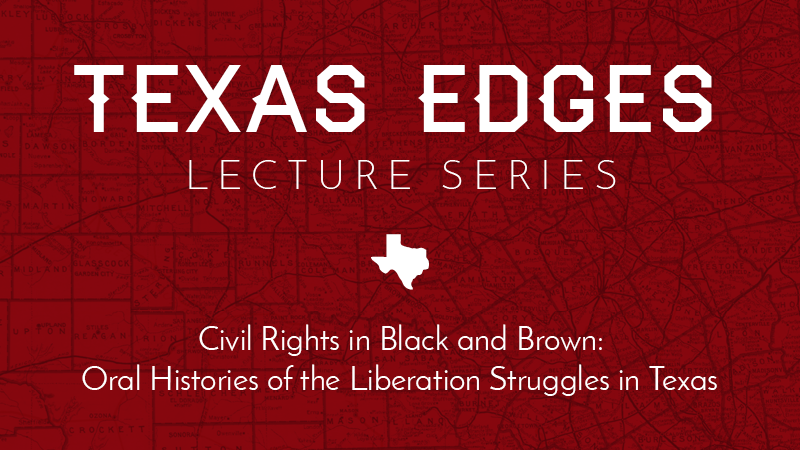
Texas Edges Lecture Series: Max Krochmal
UNT Libraries will welcome Dr. Max Krochmal, Associate Professor of History at Texas Christian University and author of Blue Texas: The Making of a Multiracial Democratic Coalition in the Civil Rights Era as the first speaker in the new Texas Edges Lecture Series. UNT Libraries will welcome Dr. Max Krochmal, Associate Professor of History at Texas Christian University and author of [Blue Texas: The Making of a Multiracial Democratic Coalition in the Civil Rights Era][] as the first speaker in the new Texas Edges Lecture Series. Dr. Krochmal’s lecture, titled “Civil Rights in Black and Brown: Oral Histories of the Liberation Struggles in Texas,” will feature the Civil Rights in Black and Brown Oral History Project, a statewide research initiative that has collected more than 530 new interviews to reconstruct the hidden history of the overlapping African American and Mexican American civil rights movements in Texas. The lecture will take place from 1-2 p.m. on Thursday, November 29 in Willis Library, Room 250H and is free to the public. Dr. Krochmal hopes to provide needed insight into the intertwining histories of the African American and Mexican American civil rights movements in Texas. “Not one but two insurgencies challenged [Texas]’s twin caste systems, and they did so in intimate conversation. They flourished in unlikely places, urban and rural, and spanned decades before and after 1965, continuing into the 21st century. Despite the slow pace of change, activists of all ages forged powerful movements for self-determination. Some filed lawsuits for school integration and canvassed door-to-door to win political power. Others picketed to demand criminal justice reform and sought to improve public services in their cities. Still more activists joined unions and built neighborhood associations to challenge ongoing economic injustice. Across the Lone Star State, organizers pointed out the ways in which integration failed to produce equity, prompting them to also build their own community-controlled healthcare, educational, and cultural institutions. Women played leading roles throughout these campaigns, challenging the sexism of their comrades as well as that of the larger society. The polyglot activists also developed a variety of relationships with one another, from protracted collaboration to stiff competition—and everything in between.” The Texas Edges Lecture Series aims to emphasize innovative work pushing boundaries in various directions – digital in many cases, but other ways, too. This is a new lecture series to take place every fall in collaboration with the UNT Department of History and The Portal to Texas History. digital_libraries_presentations_and_lectures
Posted:
11/07/2018
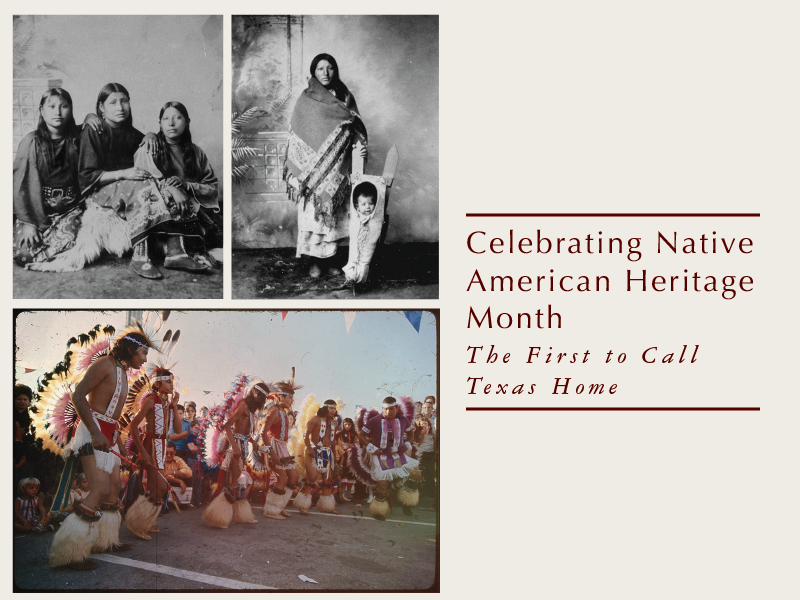
Monthly Spotlight: Celebrating Native American Heritage Month
In the spirit of rediscovery during National Native American Heritage Month, we decided to round up a few resources from UNT Libraries about the rich indigenous cultures of Texas. Here’s a fun mental exercise. Next time you’re making the commute to campus or taking a shortcut on one of the many farm-to-market roads scattered throughout the metroplex, take a moment to imagine your route without any of the modern features you take for granted. Remove the cars from the road. Remove the road. Wipe the signs and roadside businesses from the corners of your vision. Try to picture what this area looked like before. It’s a small thing, that appreciation, but it’s worth the few minutes to remember what Texas was to the people who called this land home before European colonization. Especially this November, officially designated National Native American Heritage Month. In that spirit of rediscovery, we decided to round up a few resources from UNT Libraries about the rich indigenous cultures of Texas. Caddo: The Namesake The Caddo were an agricultural society that called the Piney Woods of East Texas home, and their territory stretched out into Oklahoma, Arkansas, and Louisiana. The Caddo relied heavily on the abundant forest wood to build their sturdy huts, canoes, and bows. Their position in East Texas made their downfall a complicated one, as documented in The Caddo Indians: Tribes at the Convergence of Empires. Various European nations made contact with the Caddo around the same time – Spain first, in a bloody clash with the Hernando de Soto Expedition. As explorers and settlers from France, England, and the United States followed over the next century, the sophisticated Caddo tribes negotiated peace treaties with each European nation they came in contact with. Their amenable nature toward the white European colonists kept them out of the crosshairs of American removal campaigns for a while; various Caddo tribes agreed to resettlement treaties leading up to the Texas Revolution in the 1830s. Anglo-American settlers in the region used táysha (the Caddoan word for “friend”) to name their new country: The Republic of Texas. Lipan Apache: West Texas Warriors The Apache people is still one of the most significant Native American cultures in the United States. Over 111,000 Apache peoples exist today, a reminder of just how vast and culturally diverse the Apache world was at its peak. Apache ancestors are thought to have migrated from Canada, and two Apache tribes eventually matriculated to the Texas area. While the Mescaleros moved to New Mexico, the Lipan Apaches held sway over West Texas. (The Apaches: Eagles of the Southwest tries to weave the sprawling Apache history into one book.) While Apache people are remembered for their skill on horseback and fierce defense of their homelands in wars with the United States, UNT Libraries offers a few fascinating books about Apache culture. Apache Women Warriors by Kimberly Moore Buchanon Women in Apache society were asked to serve in many different roles, setting them apart from European and American women of the day. They fought in battles, served as religious mentors and were far less passive than pop culture might have you believe. Apache Mothers and Daughters: Four Generations of a Family by Ruth McDonald Boyer and Narcissus Duffy Gayton Along the same lines, this book follows one Apache family for 35 years to show “the key roles women play in tribal life” and “the strength and the stamina of Apache women.” Karankawa: Lords of the Coast Ask Spanish explorer Álvar Núñez Cabeza de Vaca, one of four survivors of the doomed Narváez expedition in 1527, and he’ll tell you the Karankawa were a peaceable sort. Nevertheless, harmful myths have evolved about the Karankawa over the centuries, no doubt because the Europeans who wrote about them coveted their coastal lands. But de Vaca, the first European to make contact with a Texas Native American culture, was not only nursed back to health by the Karankawa but allowed to live among them as a trader for seven years. French explorers later also reported the Karankawa were a friendly people adaptable to the unpredictable coastal weather and particularly adept at facilitating trade among both native tribes and new Europeans. Instead, it seems it was Texan colonists that spurred the Karankawa into the sort of violence they are known for today. Moses Austin, the father of Stephen F. Austin, tried to settle 300 families in the Galveston area in 1821. The Karankawa resisted the settlement of their lands, and the two groups fought violently for the next decade until Stephen F. Austin drove the Karankawa from their homelands. The Karankawa essentially died out by 1858, ending the reign of one of Texas’ most potent and influential early native peoples. You can read more about these important early Texans here. Jumano: The First Traders Haven’t heard of the Jumano people before? Many haven’t. Spanish explorers in the 16th century recorded meetings with them, but their expansive travel network kept anthropologists from pinning them down for centuries. Then came University of Texas anthropologist Nancy Hickerson and her 1994 book, The Jumanos: Hunters and Traders of the South Plains. Billed as the first full-length study of the elusive Jumano society, the book explains the crucial role the Jumano played as traders and political movers-and-shakers along what would become the Rio Grande border between Texas and Mexico, stretching as far east as Caddo territory. Hickerson’s book argues the Jumano became mercenaries and spies for the Spanish before disease reduced their numbers and their influence by the 1750s. Her book fills in gaps not only in the history of South Texas but the trade interplay between native tribes in the South Plains. The Jumanos may not be the enigma they once were, as their importance to Texas is just beginning to be unearthed. Wichita, Tawakoni and Waco: People of Gold Someone once convinced a Spanish explorer named Francisco Coronado that he had seen one of the fabled Seven Cities of Gold in a place that would become the American southwest. Following his claim was a mistake that led to the European discovery of the Wichita people in Kansas on one of the most fruitless and consequential Spanish explorations in history. In 1541, Coronado’s expedition had reached and razed Cibola, a pueblo town in New Mexico they incorrectly thought was one of the fabled Seven Cities of Gold. Undeterred, Coronado followed a tip from a Native American slave named The Turk that the real city of gold (named Quivira) lay elsewhere. He eventually reached Quivira near present-day Dodge City, Kansas. There he encountered the tall Wichita people, likely one of the numerous tribes dotting the plains that spoke the same language. The only gold was the sunlight glinting off their large, dome-shaped straw huts in a scattered pattern that indicated a people unaccustomed to threats. That changed after European contact and the encroachment of the Apache from the south and Osage from the east. By the 1700s, these factors had pushed the various Wichita peoples out of their homelands, and some settled as far south as the North Texas area, where two Wichita tribes lived: the Tawakoni and the Waco. The Wichita were not a nomadic people until contact with Europeans, and F. Todd Smith’s book illustrates how the Wichita, so separated from one another and their ancestral lands, struggled for survival in new lands during the 18th and 19th centuries in the area many UNT students call home today. Comanche: A Proud Texas People The Comanche carved out a unique place in the history of North America’s native people due to their bands’ vigorous warfare, nomadic lifestyle and the important role of “The Comanche Code-Talkers” during World War II. A few of the five major bands of Comanche ruled swaths of Texas, including the Penateka (Central Texas), Quahadis (Panhandle) and the Nokoni, Tanima and Tenawa (Cross Timbers region, including Denton). The Comanche were defined by horses and democracy, the former giving them mobility to hunt and fight well and the latter providing Comanche society with an individual freedom that clashed with the invasive and divergent European cultures. It took almost 200 years for various countries – first Spain, then Mexico and the Republic of Texas, and finally the United States) to remove “the Lords of the Southern Plains” from their vast territory, a series of conflicts known as The Comanche Wars. It’s no wonder a people with such a prominent role in American history has over 80 resources available through UNT Libraries. Here are just a few that stand out: The Comanche Empire by Pekka Hämäläinen The author of this book set out to challenge the assumption Native Americans were passive victims of European expansion. Instead, The Comanche Empire traces the Comanche’s path to power and the fierce resistance they put up to save their empire. Myth, Memory, and Massacre: The Pease River Capture of Cynthia Ann Parker by Paul H. Carlson and Tom Crum Cynthia Ann Parker was only 10 years old when her family was murdered by Comanche in 1836. Taken captive, she lived as a Comanche for the next 24 years, fully embracing her new life. This book recounts her recapture and reassimilation into settler society in 1860 by Texas Rangers: “The reports of these events had implications far and near … for Parker, they separated her permanently and fatally from her Comanche husband and two of her children; for Texas, they became the stuff of history and legend.” Empire of the Summer Moon: Quanah Parker and the Rise and Fall of the Comanches, the Most Powerful Indian Tribe in American History by S.C. Gwynne Cynthia’s son, Quanah Parker, became the last chief of the Comanche during the Red River War, the military campaign by the United States to remove Native American tribes from the Southern Plains. When Quanah Parker surrendered at Fort Sill in Oklahoma, it marked the end of Native American’s free life on the plains. access_services_in_the_news
Posted:
11/02/2018

Library Legacies: Jean Harden
Library Legacies is a story series featuring the faculty and staff that have been longtime members of the UNT Libraries. Library Legacies is a story series featuring the faculty and staff that have been longtime members of the UNT Libraries. How long have you worked at the libraries? Jean had already started working in cataloging when she was told about a new opportunity as a Music Cataloging Librarian at UNT Libraries. After interviewing in the summer, she moved from Rochester, New York to Denton, Texas in September 1994. She was able to find an apartment from a connection of a person retiring from the music library. Moving in the heat of the summer wasn’t ideal, so Jean made sure to contact Denton Co Utilities to ensure that water and electricity would be turned on when she arrived. Email wasn’t quite popular yet, and they were hesitant to provide service without her coming into their office. After many phone calls and explanations of “I live in New York and cannot come in” they finally acquiesced if she promised to come in the day after she arrived, and with that she prepared for her move to Texas. What jobs have you had at the libraries? Jean started in the Music Library as a Music Cataloging Librarian and continued in that position until 2013 when she became the Coordinator of Music Technical Services. Do you have a favorite collection? Jean loves medieval music. To complete her doctorate from Cornell she studied for one year in Paris to complete her dissertation entitled “Sharps, flats, and scribes: Musica ficta in the Machaut manuscripts”. Machaut is a poet and composer who wrote in the 14th century. What are three things you do in your job? Besides coordinating music cataloging, Jean is a member of RDA (Resource Description and Access). This international committee works to set a standard for descriptive cataloging and provides instructions and guidelines on formulating bibliographic data. Working internationally has provided Jean with great opportunities to contribute to her craft, and learning opportunities as well. In one case, the Finnish representative had vetoed proposed changes to a naming system regarding the pluralizing of titles. Upon further research, Jean found that making a work plural in Finnish doesn’t quite work the same as in English, it makes a whole new word. This would mean that similar titles would be placed nowhere near each other if the naming standards would to change. Jean entitled this debacle “The Finnish Exception”. Additionally, Jean is teaching a course on music cataloging. This hands on class allows students to practice cataloging with real items, and gifted students may even be able to process video. Jean’s textbook, recently featured in the Faculty Author Exhibit, is the cornerstone of this inverted classroom where students read outside of class and get practical experience during the lesson. What’s changed since you started here? Digitization has really gotten popular in every vein of library operations, books checkouts are recorded digitally and no longer with stamped cards and the cataloging databases Jean uses see constant improvements and changes. But even digitization of processes and materials has not reduced the enormous size of the music library. In a culling effort, over 60,000 titles were moved to remote storage, and Jean could hardly tell the difference when they were removed. The collection continues to grow and it’s currently over 300,000 titles. What is something you are looking forward to in the upcoming year? Jean will be retiring in May of 2019 and although she may be leaving UNT Libraries her work in cataloging will continue. She will be working on the second edition of her book, Music Description and Access: Solving the Puzzle of Cataloging. RDA will be releasing updated standards soon so Jean plans to update her textbook “Music Description and Access: Solving the Puzzle of Cataloging.” external_relations_in_the_news
Posted:
10/16/2018
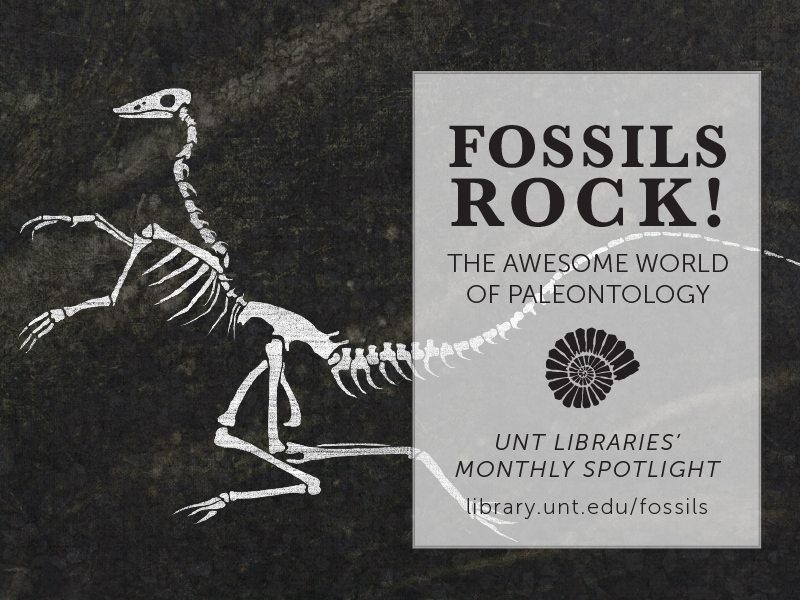
Monthly Spotlight: Fossils Rock!
The first week of October is upon us, and so is National Fossil Day. The National Park Service and the American Geosciences Institute host the National Fossil Day festivities each year, and that inspired us to dive into our UNT Libraries bookshelves to find out what kind of fossilized, dino-riffic resources we have available. Lots, as it turns out! So join us as we dive into some rocks, bones, and books. The first week of October is upon us, and so is National Fossil Day. The National Park Service and the American Geosciences Institute host the National Fossil Day festivities each year, and that inspired us to dive into our UNT Libraries bookshelves to find out what kind of fossilized, dino-riffic resources we have available. Lots, as it turns out! So join us as we dive into some rocks, bones, and books. Fossils – What Are They? What defines a fossil? Look no further than its name: fossilis is Latin for “obtained by digging.” As the eons pass, things die. As living things died out, they become preserved through some hard-to-pronounce ways such as: Permineralization Authigenesis Adpression Bioimmuration And so on. But for simplicity’s sake, we’ll say that things die, a lot of dirt falls on them, and they get preserved for paleontologists to dig up thousands of years later. And we mean thousands upon thousands. Consider that recorded human history only dates as far back as six thousand years ago. Humans, as they appear today, didn’t evolve until 200,000 years ago. Meanwhile, estimates for the earliest life on earth range anywhere from 3.77 to 4.5 billion years ago. That’s quite a gap, and fossils are the key to filling it in. Ever since Charles Darwin introduced evolution to the world, paleontology has worked to explain it. So what kinds of formerly living things can become fossils? We know dinosaurs can, but that’s just one example. Luckily you don’t have to be a giant thing to get stuck in a rock for millions of years. As Helmut Mayr’s handy guide points out, anything from small birds to insects has been found fossilized by paleontologists. The fossils that require microscopes to study are some of the most important finds because they help paleontologists study changes in the Earth’s climate over millions of years. So next time you use hand sanitizer know you’ve made a future paleontologist cry. Let’s Talk About Dinosaurs As you know from movies such as “Jurassic Park” and “The Land Before Time,” we were not always the top species on the planet. For about 177 million years, these wondrous and mysterious beasts roamed the supercontinent of Pangea. Books like “The Historical Atlas of The Earth” offer a good sense of what their world was like back then. Think Houston, but everywhere: the 45th parallel – around the United States-Canada border today – felt as humid, muggy and warm as a summer morning in Galveston. The North Pole was green with vegetation. And then everything died. More on that in a second. Fans of “Jurassic Park” will be pleased to learn that some of the dinosaurs featured in those films likely roamed right here in North Texas. According to “Dinosaurs of the Southwest,” the fossils of “carnivorous dinosaurs are reported to be more common in Cretaceous strata in New Mexico, Colorado, Texas, and Utah than in beds of the same age in the northern regions of the United States.” The author, Ronald Paul Ratkevich, tells a particularly stirring tale of local paleontology: “One particularly interesting discovery was made at Glen Rose, Texas. In lower Cretaceous limestone, representing an ancient beach, the tracks of a great sauropod could be seen making their way across the mud. Superimposed on these are the footprints of a large carnosaur clearly on the hunt. When the sauropod tracks turn to one direction, so do those of the carnosaur; its own clawed feet stepping directly onto the deeper prints of its prey.” Glen Rose is an hour and a half away from Denton. The Great Extinction Wars The Atlantic published a fascinating article recently about the ongoing debate over the fate of the dinosaurs in the scientific community. The dinosaurs all died out 66 million years ago during the Cretaceous-Paleogene (K-Pg) extinction event, which claimed the life of three-quarters of the Earth’s biosphere. (In case you were wondering, no, that isn’t the worst extinction event in our planet’s history. That would be the Permian-Triassic extinction event, also known as “The Great Dying,” that killed off 96 percent of marine species and 70 percent of land animals. Even insects died en masse. Gulp.) We thought we solved the mystery of dinosaur death in 1980 when scientists discovered evidence supporting the theory a massive asteroid struck the Yucatan Peninsula and caused the K-Pg extinction. Many books about this solution are in UNT Libraries, including some written shortly after the discovery and years beyond. However, as the article in The Atlantic points out, the asteroid theory is coming under renewed scrutiny. And that’s a good thing: science’s role is to keep asking questions and looking at the evidence. That’s where fossils still play a huge role. Meanwhile, our research for this article seriously heightened our interest in extinctions beyond that of the dinosaurs. In the process, we discovered dozens of fascinating books written in the past 20 years about the subject, from the Ice Age animals to the importance of fossils in understanding extinctions to the extinctions humans could cause and are causing. Here’s just a few: The Call of Distant Mammoths: Why the Ice Age Mammals Disappeared Did you know the last mammoths were alive around the time the Egyptians were building the pyramids? That’s less than 4,000 years ago. The Worst of Times: How Life on Earth Survived Eighty Million Years of Extinctions The fact we’re around even to examine fossils is remarkable. This book explains the resiliency of life on Earth. As one might expect, many recent books about extinctions focus on global warming and the future. Some examples are Under A Green Sky, Seasick, The Sixth Extinction, and Terra. Perhaps we should be grateful for the death of the dinosaurs since it more or less led to the rise of humanity. And author Jan Zalasiewicz asks a fascinating question in the title of her book The Earth After Us: What Legacy Will Humans Leave in the Rocks? Someday our species will be fossils, too! Where can I do fossil-hunting of my own? Ah, the age-old question first posed to us by Star Wars: Where’d you dig up that old fossil? Any kid who got to go on a “dig” field trip in elementary school loved it. The good news is that option is still available to you! We already mentioned Glen Rose, home of the Dinosaur Valley State Park. The Ladonia Fossil Park holds cretaceous fossils as well as remains of more recent animals like sharks and mammoths. Just up the road, in Sherman, you can park off Travis Street and find fossilized shells at Post Oak Creek. Finally, the fossil park in Mineral Wells lets you bring fossils you find back home with you, the dream of anyone who watched “Jurassic Park” and thought that was a good idea. access_services_in_the_news
Posted:
09/27/2018
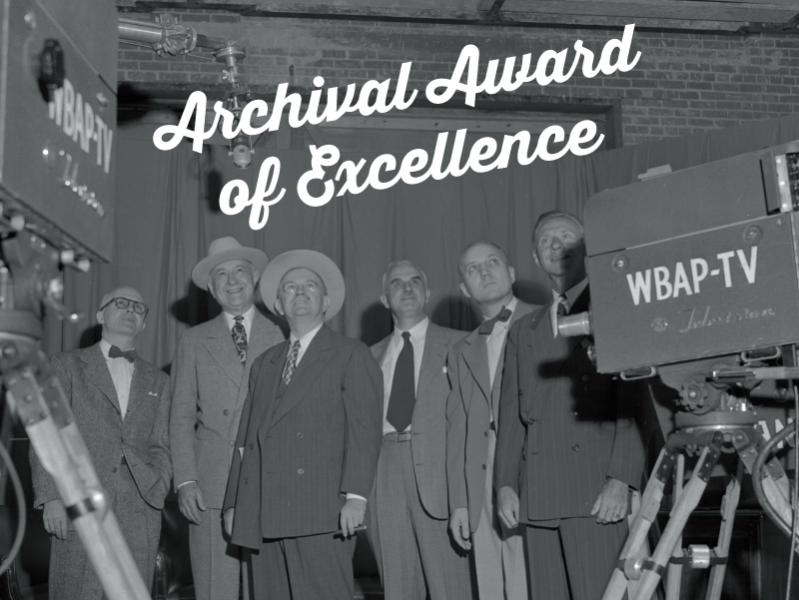
UNT Libraries to receive 2018 Archival Award of Excellence for NBC5/KXAS digitization
UNT Libraries is the 2018 recipient of the Archival Award of Excellence. The Texas Historical Records Advisory Board (THRAB) selected UNT Libraries’ work to preserve the NBC5/KXAS Television News Archive. UNT Libraries is the 2018 recipient of the Archival Award of Excellence. The Texas Historical Records Advisory Board (THRAB) selected UNT Libraries’ work to preserve the NBC5/KXAS Television News Archive. Over the past few years, UNT Libraries has worked to digitize records from NBC5/KXAS, the oldest television news station in Texas. UNT Libraries has worked to preserve 20,000 individual news segments dating from 1951 and raised over $600,000 to support continued efforts. The THRAB notes these are “significant achievements in safeguarding and promoting our state’s rich documentary heritage.” The NBC5/KXAS (WBAP) Television News Archive Project began in 2013 with the transfer of the KXAS physical archive from Fort Worth to Denton. By July 2014, the first digitized content from the collection made its way online. So far, the team has successfully digitized and shared over 10,000 archival news segments and over 36,000 original broadcast scripts to The Portal to Texas History. The UNT Libraries Special Collections team members also work closely with filmmakers to identify relevant footage in the archive and perform scan-on-demand requests to make it available for news and documentary programming. Filmmakers and UNT librarians then negotiate licensing agreements for commercial uses of film, creating a stream of revenue to be invested back into the project fund. PBS, Vice News, ESPN, NFL Films, A&E, Investigation Discovery, and the Sundance Channel are just a few of the many outlets to take advantage of the UNT Libraries’ NBC5/KXAS project. Some of the footage includes: The AIDS crisis as it unfolded in Dallas in the 1980’s Ann Richard’s gubernatorial campaign in 1990 In-depth coverage of the Branch Davidian standoff in Waco in 1993 Footage of Liberace, Bob Hope and John Belushi (among many other celebrities) Comprehensive coverage of boxing, golf, and football. Through the NBC5/KXAS digitization project, UNT Libraries can watch the complete history of television news unfold before our eyes as footage is added to the digital library. The Archival Award of Excellence was established by the THRAB to “honor a Texas institution for its projects and/or ongoing programs that build collections, enhance access to archives, develop effective digitization programs, or implement preservation strategies.” UNT’s efforts with the NBC5/KXAS archives are only possible through the cooperation and coordinated efforts of many UNT Libraries’ departments including Administrative Offices, Facilities and Systems, Digital Libraries, Special Libraries, and External Relations and Advancement. UNT’s selection as the 2018 Archival Award of Excellence recipient will be formally announced by the THRAB on October 1 to kick off their Texas Archives Month celebration. Members of the NBC5/KXAS digitization project team will be present for the award presentation during the DFW Archives Bazaar on October 14 at Dallas Heritage Village. UNT Libraries Honored for Work Digitizing NBC 5 Archive external_relations_honors_and_awards
Posted:
09/24/2018
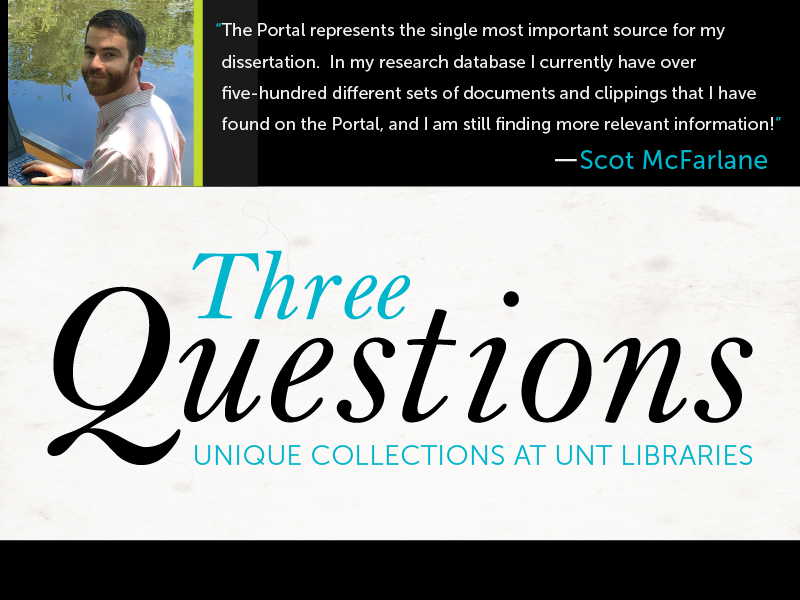
Three Questions with Scot McFarlane
Scot McFarlane grew up in Concord, Massachusetts, and Palestine, Texas near the Trinity River. Currently a Ph.D. Candidate at Columbia University, his work has appeared in The Journal of Southern History and Environmental History. At Columbia, Scot has helped teach Mexican History, the History of the South, the History of New York, and is currently drafting a syllabus for a seminar on the history of rivers in North America. Three Questions is an initiative to share the value that our faculty, students, and others in the UNT community derive from using The Portal to Texas History at UNT Libraries. 1. How important are Unique Collections in your teaching, learning or research? The Portal represents the single most important source for my dissertation. In my research database I currently have over five-hundred different sets of documents and clippings that I have found on the Portal, and I am still finding more relevant information! Likewise, the Portal should be a great teaching resource at all level of education from high school to graduate study: its vast collections make it possible to assign a research paper and have students do focused searches on any aspect of Texas history. You are not simply sending students out to get lost “googling” things, the Portal is a much more effective starting point. The fact that the Portal is a free database means that no matter where I am researching or teaching that I will be able to depend on it throughout my career. 2. How have Unique Collections changed the way you approach your research, teaching or learning? The Portal has made it possible for me to do the research necessary to cover the time and space that I have proposed for my dissertation on Trinity River in the 19th and 20th century. My geographic focus is at once narrow and broad, I am only interested in places within ten miles of the river, but of course the Trinity cuts across the entire state of Texas. The Portal allows me to explore this particular swath of the state’s history—mainly I can use the keyword functions while also reviewing sources tagged by county. At this point I have visited about fifty different archives spread throughout Texas and the rest of the United States, and all of that travel is constrained by both money and time. In contrast, I have been able to do sustained research on the Portal from any location. Knowing that my research on the Portal has been as comprehensive as possible has given me the confidence to start writing. 3. What do you want others to know about your research, teaching or learning? Though North Texas and East Texas may appear to be two very different places, the history of the Trinity River shows how these two worlds are connected, both physically and politically. While it was North Texas boosters who wanted to canalize and destroy the Trinity River in the middle of the twentieth-century, they relied on an array of local politicians and elites all along the river. Similarly, in 1973 when the plans to canalize were put to a vote in all of the Trinity River counties it was a coalition of people in both East Texas and North Texas who defeated the much better funded canal proponents. Rural people are rarely labeled as environmentalists but, like many of the East Texans in the history of the Trinity River, they both understand and care deeply about the landscape they call home. Scot McFarlane grew up in Concord, Massachusetts, and Palestine, Texas near the Trinity River. Currently a Ph.D. Candidate at Columbia University, his work has appeared in The Journal of Southern History and Environmental History. At Columbia, Scot has helped teach Mexican History, the History of the South, the History of New York, and is currently drafting a syllabus for a seminar on the history of rivers in North America. Prior to moving to NYC, Scot taught writing and history at high schools in the Willamette River Valley of Oregon. You can follow his research on his blog. external_relations_in_the_news_did_you_know
Posted:
09/20/2018
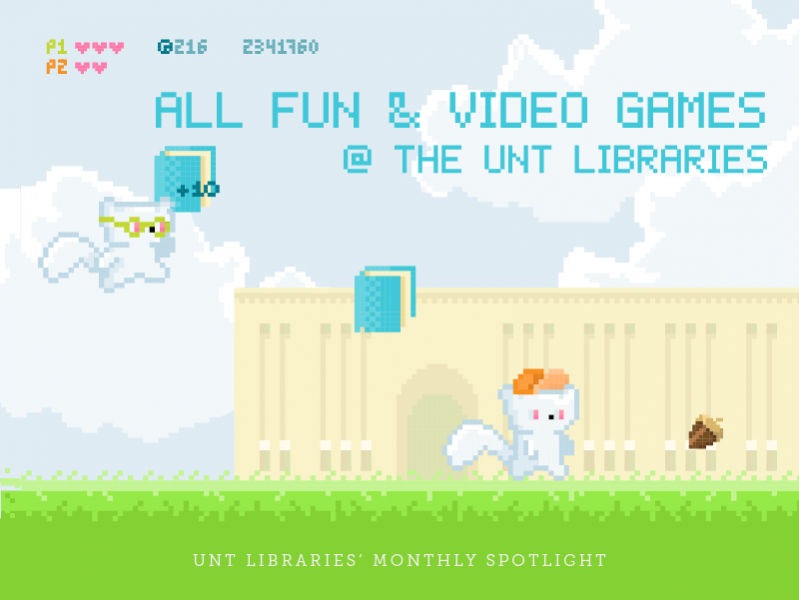
Monthly Spotlight: All Fun And Video Games
Welcome back to UNT Libraries, students! Let’s talk about video games. Yes, that sentence sounds a little anachronistic. Libraries and video games? Who runs this place, dogs and cats? (Ed. note: We wish.) The truth is you’ll be hard-pressed to find a more well-rounded collection of gaming-related resources than here at UNT Libraries. Our Media Library hosts a plethora of classic and new titles to play for yourself, but the sheer range of video game books across our libraries may surprise you. Whether you want to learn how to create games, learn how the industry works or study the psychological and sociological effects of gaming, UNT Libraries has a book for you. Gaming is for everyone, the saying goes and nowhere is that more accurate than at UNT Libraries. Let’s explore just a fraction of your options! If we don’t touch on something you like, searching for video games in our catalog is easy: just follow this link and browse to your heart’s delight. Let’s Just Game! God of War (2018) Yep. We’ve brought out the big guns first. One of (if not the) most critically acclaimed games of the year is yours to borrow from UNT Libraries. If you’re a fan of Norse mythology, action games, elaborate stories about father-son relationships and large axes, then we can’t recommend this title enough. Journey Released in 2012 by a tiny studio in California, Journey features a simple premise with profound emotional experiences. You play as a robed figure traversing an immense desert toward the peak of a distant mountain. Journey earned a Grammy nomination, numerous awards and is generally considered one of the greatest games of all time. It’s not time-consuming, though! You can complete Journey in one sitting. Rocket League Combine soccer and Hot Wheels toys, and you get this surprise hit video game. Rocket League is the perfect competitive game to wind down with after a long day of classes and studying, and it’s a great one to play with your roommates. How Games Are Made Blood, Sweat, and Pixels Billed as a collection of “the triumphant, turbulent stories behind how video games are made,” this book by Kotaku writer Jason Schreier is a must-read for any fans of the gaming medium. Schreier’s in-depth reporting shows just how grueling it was to create some of your favorite games, from successes (like Destiny, The Witcher 3 and Dragon Age: Inquisition), infamous failures (Star Wars 1313) and many, many more. Women in Game Development: Breaking the Glass Level-Cap Much like game culture itself, game development is usually considered a dominion for men. At least, it was: the last ten years have shown that games are for everyone and have been for everyone all along. But the development of games has not quite opened doors so readily to women, who suffer through harassment, dead-end careers, and minimization to this day. Veteran game designer Jennifer Brandes Hepler gives the women of game development a voice and hope in this remarkable book. How Games are Written A Mind Forever Voyaging: A History of Storytelling in Video Games Moral gaming in Ultima IV. The rise of cutscenes in Metal Gear Solid. The expensive interactive cinema of Heavy Rain and indie-budget minimalism of Dear Esther. Dylan Holmes traces the evolution of narrative technique in video games from the early 80’s to the present day in A Mind Forever Voyaging, a book that “captures the best that video games have to offer.” The Game Narrative Toolbox Hey, look, another outstanding book by Jennifer Brandes Hepler! She and three other experienced narrative game designers joined together in 2015 to create this essential text for any writers considering a career in the video games industry. The Toolbox is full of exercises, as well. Books About Game Culture Crash Override: How Gamergate (Nearly) Destroyed My Life, and How We Can Win The Fight Against Online Hate Zoe Quinn was a video game developer when her ex-boyfriend posted a negative blog post in 2014 about her that sparked “Gamergate,” a sustained harassment campaign conducted against female developers and journalists that rocked video game culture to its core. Gamergate was a heated front on our broader culture war still being fought today across society. Quinn’s book discusses how Gamergate harmed her and how gaming culture can be better. God In The Machine: Video Games as Spiritual Pursuit “Free will vs. determinism, the importance of ritual, transcendence through mastery, notions of the self, justice and sin, life, death, and resurrection—these all come into play in the video games that some critics so easily write off as mind-numbing wastes of time.” Author Liel Liebowitz creates a staggering comparison between the storytelling power of video games and the great philosophers of our past in a book full of optimism about how gaming can enrich our lives. It isn’t a hard book to read, however! It’s a pretty easy thing for a book that tackles such big subjects. The Big Questions About Gaming How to Talk About Videogames Author Ian Bogost writes that video games are “part art and part appliance, part tableau and part toaster.” That zany description is just a taste of this book’s dive into the fundamental difference between video games and other kinds of art. Bogost examines familiar games like Madden NFL, Mario Kart, and Ms. Pac Man as well as fads like Flappy Bird and FarmVille to sort out the reasonable and unreasonable ways we treat gaming experiences. Extra Lives: Why Video Games Matter Gaming culture has slowly crept into the mainstream conversation over the seven years since Tom Bissell wrote this acclaimed book. That doesn’t mean it’s not worth your time, however, especially if you still look down on the medium or want to know why you should care about it at all. Bissell goes to great lengths in this pseudo-memoir to explain the appeal, artistic capabilities and unique qualities of video games that make them a worthy peer of traditional art forms. Beyond Choices: The Design of Ethical Gameplay And yet, as games become more and more popular, important questions must be asked. Video games are a uniquely interactive medium, and many of them ask players to make moral choices. The severity of the consequences can vary, but one thing doesn’t: the effects remain inside the game reality. With that in mind, Miguel Sicart argues in Beyond Choices that “games that engage players ethically enable us to explore and express our values through play.” The book is a fascinating look at both the moral education available in video games and the incredible responsibility that puts upon game designers. The Video Game Debate: Unravelling the Physical, Social, and Psychological Effects of Video Games Social science research on video games is relatively new, but this book by Rachel Kowert and Thorsten Quandt received praise even within the games industry. The Video Game Debate is broader than Beyond Choices; it seeks answers to gaming questions our American culture has grappled with for decades. Do video games make children violent? Are video games addicting? Do they help or impair cognitive performance? This book is like an open forum, with views from students, game developers, politicians and scholars expressed alongside independent research. access_services_in_the_news
Posted:
09/06/2018
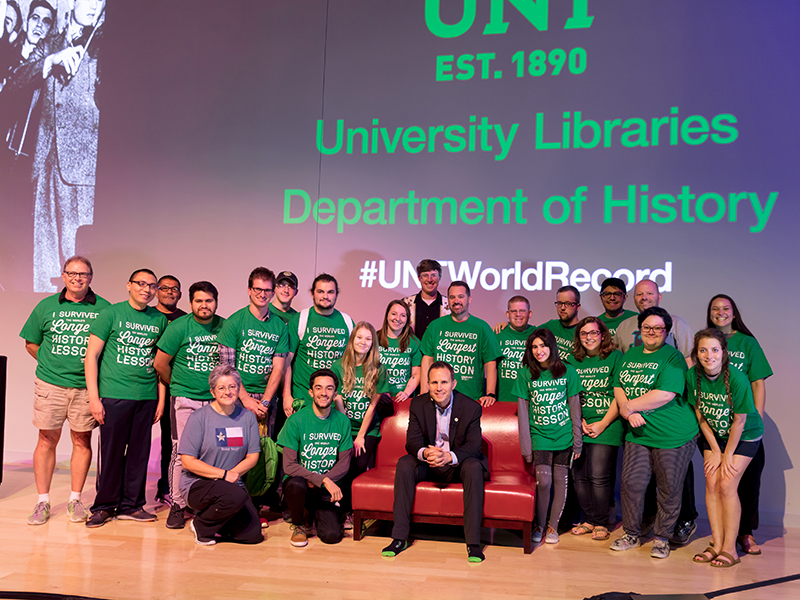
GWR World's Longest History Lesson
With an assist from the Portal to Texas History, UNT Libraries and UNT associate history professor Andrew Torget kicked off the fall semester with a record-setting marathon. With an assist from the Portal to Texas History, UNT Libraries and UNT associate history professor Andrew Torget kicked off the fall semester with a record-setting marathon. A marathon of a different sort, however: beginning on Friday, August 24, Dr. Torget ran through more than 10,000 years of Texas history during an attempt to set a Guinness World Record for the longest history lesson. Over the course of 26 hours and 33 minutes, Dr. Torget and a team of library employees, videographers, and impartial official witnesses managed to set and surpass the 24-hour world record. It was a multi-department effort over a year in the making. Dr. Torget, a member of the Advocacy Board, approached Assistant Dean for External Relations Dreanna Belden in 2017 with a unique idea: to raise money for the Portal to Texas History, he would lecture for over 24 hours and break a Guinness World Record. “I thought it would be big,” Belden said. Big and original, as it turned out. When Belden and Assistant Director of Departmental Marketing Joshua Sylve got in touch with Guinness, they learned nothing quite like this had been attempted before. To set the record, Dr. Torget would need to prepare and execute a lesson for 24 hours with a laundry list of guidelines. “It was [intimidating],” Sylve said. “It was a lot of reading and combing through [the Guinness guidelines] to see if there were any red flags that would impede us from even doing this. We realized we had enough individuals interested to at least get the ten witnesses to complete it. We were encouraged by that.” The UNT Libraries team decided they needed three main groups of people for such an event. The class, titled “pioneers” by the organizers, would need to be a large group of volunteers staying up with Dr. Torget as he taught. UNT Libraries External Relations scheduled 37 witnesses and had over 100 volunteers, including the class. Guinness required at least two witnesses to verify the attempt was completed and rules were met, and the witnesses had to remain on stage in shifts of four hours. Library staff volunteered to be captains that oversaw the critical duties of the witnesses. “The witnesses not only had to be at the lecture for a certain amount of time, but they also had to have their eyes on the students to make sure the students were awake and engaged,” Sylve said. “The witnesses had to be unbiased, basically saying ‘We’re not going to fib just to guarantee UNT makes the record.’ That was probably the most challenging group to secure.” The effort to host the event would span multiple UNT departments and facilities. The Union’s audio and visual team ensured the microphones, and Youtube live stream worked. Parking and Transportation helped volunteers and staff get in and out of lots safely in the middle of the night. URCM played a crucial role in getting the word out to media outlets. “Once the lesson finally started there was a weird peace,” Sylve said. “As long as [Dr. Torget] doesn’t stop talking we can handle this. It was really just a trust in him and him trusting in us that we’re prepared for everything.” By the time of the event, word of mouth had spread and drawn in passionate volunteers. “Even before we were starting, students were super into it,” UNT Libraries Administrative Specialist Sarah Allsup said. “So the students going into it were just excited about history and weren’t worried about setting a record.” Keeping everyone awake, engaged and well-nourished was a concern for the planning team. Allsup helped coordinate catering for the event. The pioneers were served lunch and dinner on Friday and breakfast on Saturday, with a scheduled snack and bathroom break every few hours during Dr. Torget’s lecture. Guinness made it clear the lesson could not be interrupted for very long at all to be considered legitimate. Dr. Torget had to hold court consistently, but he came prepared. “At no point did they want the lesson to be run by the students for cumulative five minutes,” Sylve said. “You’ll notice even as students were asking questions, [Dr. Torget] had a way of answering maybe just part of the question or repeating the question so he could take more control of the response.” The lead-up to the event wasn’t without some problem-solving. The official clock had to be replaced with minutes to spare, and graphic designer Samantha Lawrence spent mid-day on Friday re-evaluating the break schedule. “I spent two hours on an excel spreadsheet re-checking our two hour and fifty-minute carryovers,” Lawrence said. “So you saw me [on the live stream] frantically bringing sheets of paper to people after doing all of this math.” Dr. Torget’s lecture, which covered Texas history from the prehistoric era to the present day, was a fundraiser for the Portal to Texas History archive project run by UNT Libraries. As part of a challenge grant from the National Endowment for the Humanities, the Portal is trying to raise $1.5 million by 2020. Half of that goal had been met, but as a member of the UNT Advocacy Board, Dr. Torget decided such an event could help push the Portal even further. “All of the money raised through this event goes to that,” Belden said. “The Portal is important because it’s literally transforming the way historians, educators and students explore and learn about Texas history. We’ve seen that demonstrated in the way college instructors use it across Texas, and teachers use it with elementary school children and all these methods that weren’t possible before.” Dr. Torget unofficially set the record at 9 am on Saturday, but pushed past the 24-hour requirement. When Guinness confirms the record in two months, Dr. Torget’s 26 hours, 33-minute runtime will go down in history. The outreach arm of the event was a success, as the attempt was broadcast live to over five thousand viewers on Youtube around the globe and began to spread on social media through word-of-mouth. “For the public relations value alone it was worth it,” Belden said. “It didn’t make national news, I think, but it did get picked up in lots of local markets. We heard people in Iowa and Boston saw it. One of the Dr. Torget family friends told them they sat down in Ireland at a pub and started watching [the live stream] and got the whole pub to watch.” The entire lesson and event will be posted on the Portal to Texas History by the end of September. For such a long, complicated event to go off without hiccups wasn’t surprising to the UNT Libraries team. Sylve says over a year of planning ensured every conceivable problem was thought of and prepared for, and the success of the event sets an excellent example for the entire UNT community. “It’s among the top ten things I’ve put myself through that I’m proud of,” Sylve said. “I think it really did forge belief in not just our team but teams across campus to see what we can do when we collaborate.” digital_libraries_in_the_news
Posted:
08/30/2018
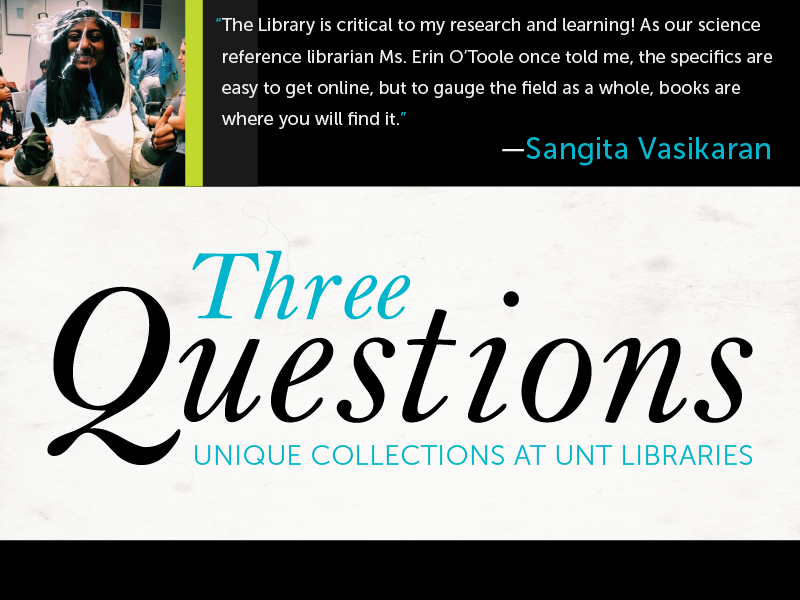
Three Questions with Sangita Vasikaran
Sangita Vasikaran is a 17 year-old infectious virology researcher from the Texas Academy of Math and Science. Three Questions is an initiative to share the value that our faculty, students, and others in the UNT community derive from using The Portal to Texas History at UNT Libraries. 1. How important are Unique Collections in your teaching, learning or research? The Library is critical to my research and learning! As our science reference librarian Ms. Erin O’Toole once told me, the specifics are easy to get online, but to gauge the field as a whole, books are where you will find it. Additionally, if I ever want a second pair of eyes to look over any of my work in the way it is worded, Ms. O’Toole is the person I go to first. The fact that I can blend my field with someone who has so much experience doing similar writing and scholarly work teaches me something new each time I visit her. Further, I am fortunate enough to be a part of the biology honor society, BBB, advised by Ms. O’Toole herself, another outlet to my constant endeavor to learn about the subject I enjoy so much. 2. How have Unique Collections changed the way you approach your research, teaching or learning? Research and learning have become more of a collaborative effort: rather than just something I do alone from my laptop in my room, with the library, I go out and hear personal experiences, tips, specialized stories, and all in all, receive deeply multifaceted help that builds my projects past a level that I have ever reached. Through this very interpersonal adventure, I also have been able to improve the way I am able to present my research, one of the most important elements to scholarship. 3. What do you want others to know about your research, teaching or learning? Be it science, art, history, or literature, there is always a quest for going past what is currently commonly known and further, sharing this with people. Being able to do this with the most complex topics helps connect us as humans towards a goal so much bigger than ourselves. Vaccines don’t cause autism! If we are able to achieve in full fledged scale the two objectives of research above, we could clear up this misconception. Sangita Vasikaran is a 17 year-old infectious virology researcher from the Texas Academy of Math and Science. external_relations_in_the_news_did_you_know
Posted:
08/28/2018
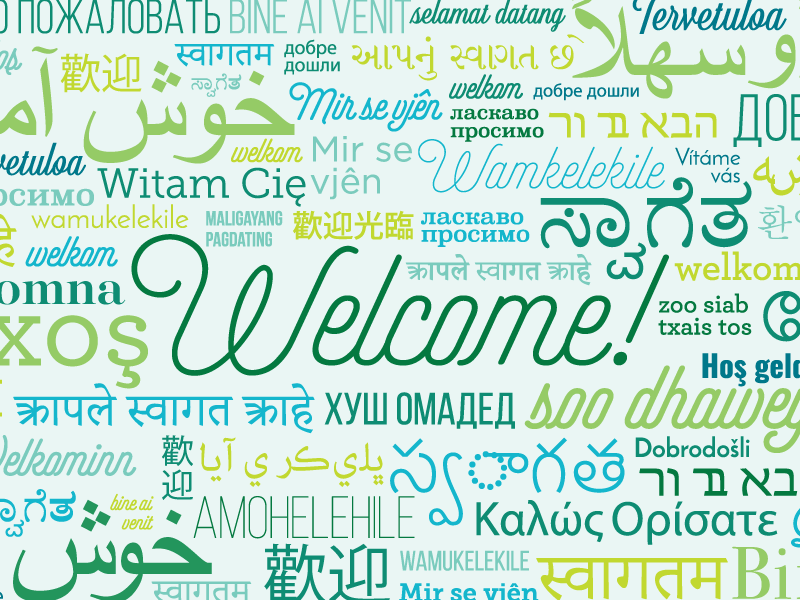
All are Welcome at UNT Libraries
Welcome to the University of North Texas Libraries. As the most-used service on campus, we value our role as a hub for learning, resources, and community for all North Texas students, faculty, and patrons. A community is not the least of those roles, and we will always work hard to ensure UNT Libraries is a safe place for everyone. Research and knowledge are essential to anyone of any background or identity, and we will always strive to make you feel welcome here. While you are here, you may want to get familiar with some of our many services across our locations at Willis Library, Eagle Commons Library in Sycamore Hall, the Media Library at Chilton Hall and the Discovery Park Library. Together, our libraries offer access to over 6 million print and digital items across many platforms (e-books, print, video, video games, virtual reality–you name it, we probably have it or will have it soon.) Our services are just as varied and center around making the life of our students and faculty as convenient as possible. We placed printers, scanners, and copiers throughout the Libraries, and laptops are available for checkout, and The Factory and Software Carpentry services can help with creative projects. And of course, we work hard each semester to make study rooms and our distinct range of study spaces precisely what you need to focus on research or other work. All of these resources and services are maintained by a diverse library staff dedicated to making UNT Libraries a comfortable, safe and enriching space for the UNT community. It is our hope and mission that you find UNT Libraries is a welcoming and essential part of your learning experience. administrative_office_did_you_know
Posted:
08/07/2018

Food for Fines
Food for Fines is now year round! The UNT Libraries Food for Fines drive has been so popular that we decided to expand it. Food for Fines is now year round! The UNT Libraries Food for Fines drive has been so popular that we decided to expand it. You may bring up to 20 cans per semester to the Library Services Desk at Willis or Discovery Park to waive your overdue fines. With each can you bring in, one dollar will be removed from your library account. Food for Fines cannot be used for damage or replacement fees. Canned food items must be: 12 oz. or more Not expired, not dented Not from a food pantry All cans are donated to the UNT Student Food Pantry. access_services_new_service
Posted:
08/03/2018
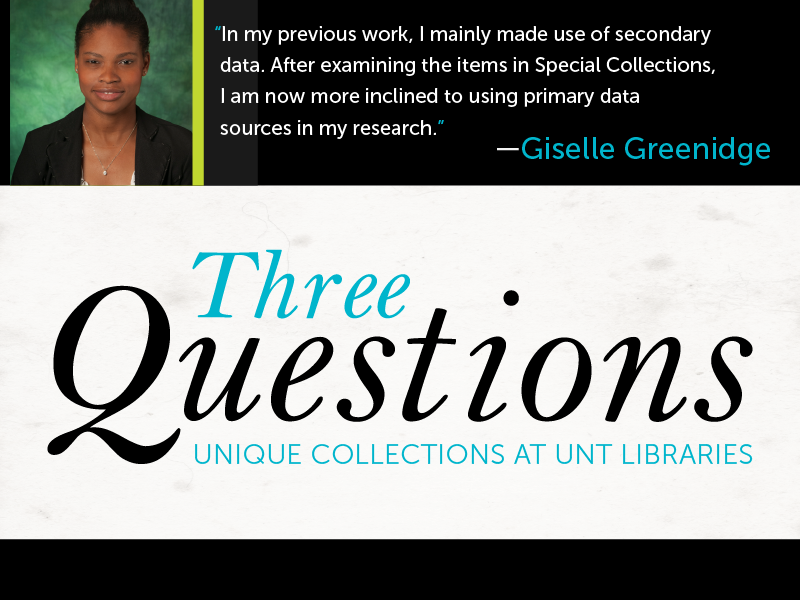
Three Questions with Giselle Greenidge
Ms. Giselle Greenidge is a doctoral student and Teaching Fellow in the Department of Sociology at the University of North Texas. Her major concentration is Global and Comparative Sociology and her minor concentration is Social Stratification. She earned master’s degrees in Behavioral Science and Merchandising. Her research interests include culture, globalization, and immigration. Three Questions is an initiative to share the value that our faculty, students, and others in the UNT community derive from using The Portal to Texas History at UNT Libraries. 1. How important are Unique Collections in your teaching, learning or research? Special Collections are invaluable resources to my learning and research. Specifically, the Black Academy of Arts and Letters’ archive has a wealth of educational materials that focus on the culture of Black minority groups in the U.S. such as African Americans and Caribbean Americans/West Indians. In addition, this archive also emphasizes the idea of Pan Africanism which is vital to my research on collaboration between the Black Academy of Arts and Letters and the Caribbean American community. Such a unique collection gives a diverse cultural perspective on Black art and history. 2. How have Unique Collections changed the way you approach your research, teaching or learning? In my previous work, I mainly made use of secondary data. After examining the items in Special Collections, I am now more inclined to using primary data sources in my research. This stems from my experience with The Black Academy of Arts and Letters collection which has over 200 boxes of documents, recordings, and photographs. As a result of this profundity, I was able to propel my research by conducting a thematic analysis utilizing administrative, support, and production files. Furthermore, I was not faced with the challenge of having insufficient information. 3. What do you want others to know about your research, teaching or learning? As someone with an Afro Caribbean identity, it is one of my lifelong ambitions to help recognize social and historical circumstances that affect this minority group, but to also increase awareness of the value of the Black diaspora. My research shows that the Black Academy of Arts and Letters has partnered with Caribbean organizations such as the Dallas West Indies United but there are some challenges to greater collaboration between the African American and Caribbean American communities in the DFW metroplex. However, I hope to make enlightening contributions with the use of this special collection to better understand organizations serving the African American and Caribbean communities, their role in society, how they operate, and how they establish objectives and outreach efforts. Ms. Giselle Greenidge is a doctoral student and Teaching Fellow in the Department of Sociology at the University of North Texas. Her major concentration is Global and Comparative Sociology and her minor concentration is Social Stratification. She earned master’s degrees in Behavioral Science and Merchandising. Her research interests include culture, globalization, and immigration. external_relations_in_the_news_did_you_know
Posted:
07/31/2018
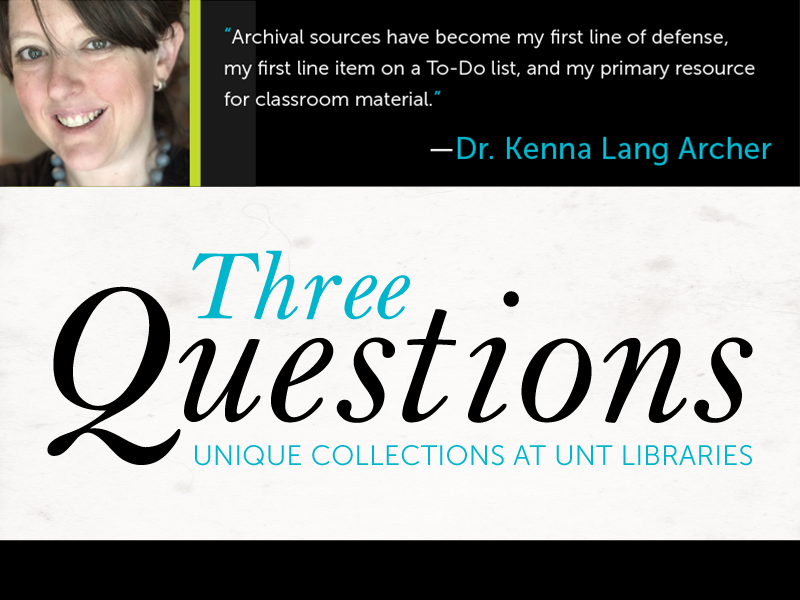
Three Questions with Kenna Lang Archer
Dr. Kenna Lang Archer is a Senior Instructor at Angelo State University in San Angelo, Texas, where she teaches U.S. environmental history, Texas history, and American history. Her first book, Unruly Waters, was published by University of New Mexico Press. She recently finished writing an updated edition of Ogallala: Water for a Dry Land with John Opie and Char Miller. She will be presenting her current research project at the Western History Association meeting in October. Three Questions is an initiative to share the value that our faculty, students, and others in the UNT community derive from using The Portal to Texas History at UNT Libraries. How important are Unique Collections in your teaching, learning or research? It is no exaggeration to say that the Unique Collections are necessary for me to do my work. In the classroom, I incorporate primary sources into every lecture, and my personal research unequivocally depends on my ability to access primary sources that are diverse in their geography, chronology, and type. Unfortunately, it is increasingly difficult (at times, mind-numbingly so) to track down primary sources that are both authentic and available. That is why the Portal to Texas History and the Special Collections are so very important! How have Unique Collections changed the way you approach your research, teaching or learning? Primary sources allow us (as teachers, as researchers, or as students) to see history unfold not as a string of facts but as a story of diverse experiences and deep-rooted assumptions, individual struggles and shared challenges, scientific hubris and technological triumph. This is because, by their very nature, primary sources are close to the subject at hand. As I have become more aware of the impact that these sources can have in my work, I have become more dependent on Unique Collections. When I am prepping my classes, I now spend as much time parsing the sources in the Portal to Texas History as I do writing notes, prepping powerpoints, or reading textbooks. Archival sources have become my first line of defense, my first line item on a To-Do list, and my primary resource for classroom material. What do you want others to know about your research, teaching or learning? One of the courses that I teach regularly is Texas History. Frequently, I will have students who think they have heard it all (having grown up in the state), but I also get students who know absolutely nothing about the state. It can be challenging, from a teacher’s perspective, to engage students along this spectrum. For example, how do you teach the (very much loaded) story of The Alamo for both the first time and the millionth time? What I have discovered is that the sources in the Unique Collections are precisely what I need. Sources from the Portal to Texas History, for example, help to make this history more accessible, more relevant, and more intellectually uncomfortable/challenging. My students learn more and grow more when I present them with sources from the Unique Collections (they also enjoy the class quite a bit more), and frankly, I am a much better teacher when I am engaging these sources as well. Dr. Kenna Lang Archer is a Senior Instructor at Angelo State University in San Angelo, Texas, where she teaches U.S. environmental history, Texas history, and American history. Her first book, Unruly Waters, was published by University of New Mexico Press. She recently finished writing an updated edition of Ogallala: Water for a Dry Land with John Opie and Char Miller. She will be presenting her current research project at the Western History Association meeting in October. external_relations_in_the_news_three_questions
Posted:
07/16/2018
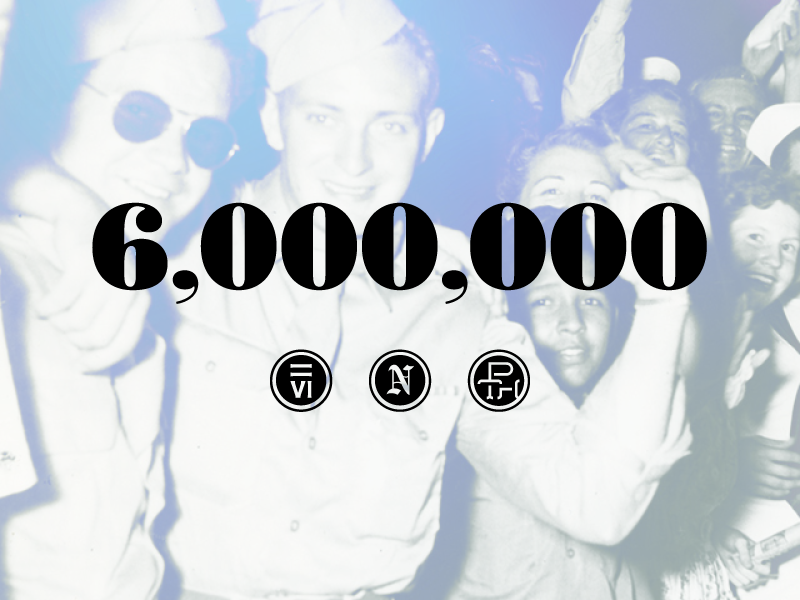
6 Million Newspaper Pages Preserved in The Portal to Texas History
At the end of June, the Texas Digital Newspaper Program reached the milestone of six million newspaper pages digitally preserved and freely accessible to the world. Represented within this most recent addition of one million pages are: 90,976 newspaper issues 34 newspaper titles Texas communities and partners from as far west as Kermit, as far south as Pharr, as far east as Beaumont, and as far north as Follett Digitization of six million pages is neither a speedy nor simple undertaking, and we thank all of the communities and researchers who have worked with us to make their newspapers available in what is becoming a vast and diverse collection of community history and identity, representing Texas across time to a worldwide audience. digital_newspaper_unit_collection_highlight
Posted:
07/06/2018
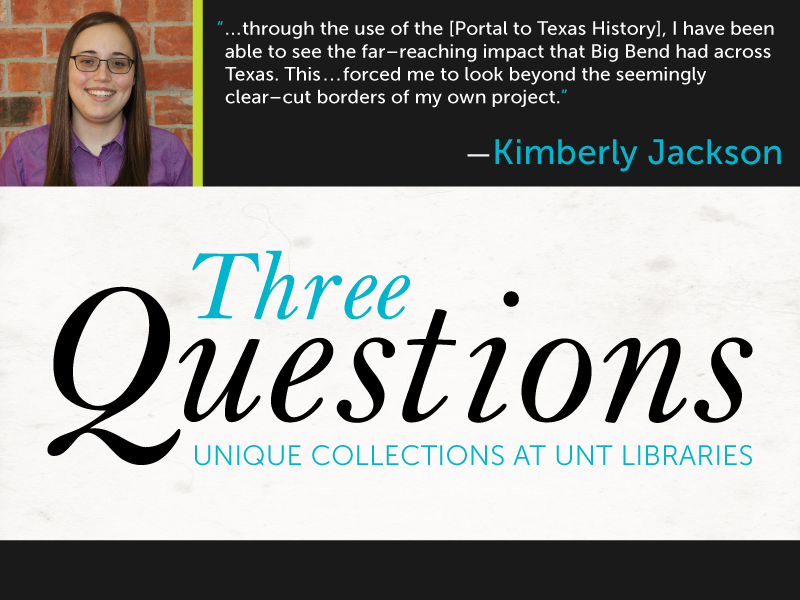
Three Questions with Kimberly Jackson
Kimberly Jackson is a master’s student and Teaching Assistant in the History Department at the University of North Texas. She earned a bachelor’s degree in history and mathematics at the University of North Texas. In the 2018-2019 academic school year, Kimberly will complete her thesis on the Civilian Conservation Corps in Big Bend National Park. Three Questions is an initiative to share the value that our faculty, students, and others in the UNT community derive from using The Portal to Texas History at UNT Libraries. How important are Unique Collections in your teaching, learning or research? The Portal is an invaluable resource for my research. In researching the Civilian Conservation Corps (CCC) at Big Bend National Park, part of my project is trying to show how invested the public was in the creation of the park. Understanding what went on in the CCC camp is only part of the story, the rest of it is comprised of the overall impact of the CCC, the legacy of the program, their projects, and Big Bend itself. In order to see this part of the story, I rely heavily on the newspapers found in the Portal. The Portal contains local newspapers from across the state and discuss the progress happening in Big Bend throughout the time that the CCC had a camp there. These newspapers help to show how the public viewed the developments in Big Bend and the larger significance of the CCC’s work there. How have Unique Collections changed the way you approach your research, teaching or learning? The Portal has helped me to expand the scope of my research. While it might be easy to think that the sources for Big Bend would be found only around the park. However, through the use of the Portal, I have been able to see the far-reaching impact that Big Bend had across Texas. This has helped to show the importance of Big Bend beyond the park’s borders, and it has forced me to look beyond the seemingly clear-cut borders of my own project. What do you want others to know about your research, teaching or learning? My research is filling a serious gap in the research of Big Bend, but even more so, it reaches beyond the park, to Texas and the nation. If it were not for the CCC’s involvement in Big Bend, the park would not exist as we know it today. Big Bend affected more than just the enrollees that worked in the camp who received invaluable training and employment during the midst of the Great Depression, it reached people across the United States. FDR found it to be so important that he paused his other duties to accept the deed to Big Bend officially placing it in Federal hands on an especially busy day, June 6, 1944 – commonly known as D-Day. Eleanor Roosevelt, his wife, stepped in on behalf of the enrollees of the camp to call an investigation of an overbearing camp officer. While these are only two examples of the reach of Big Bend, the fact that it crossed the desks of two of the most important political figures and they gave their time to it, shows not only the significance of Big Bend but the impact that it had. Kimberly Jackson is a master’s student and Teaching Assistant in the History Department at the University of North Texas. She earned a bachelor’s degree in history and mathematics at the University of North Texas. In the 2018-2019 academic school year, Kimberly will complete her thesis on the Civilian Conservation Corps in Big Bend National Park. Her larger academic interests include borderlands and environmental history and hopes to apply her research to larger studies of the U.S.-Mexico Border. external_relations_in_the_news_three_questions
Posted:
06/27/2018
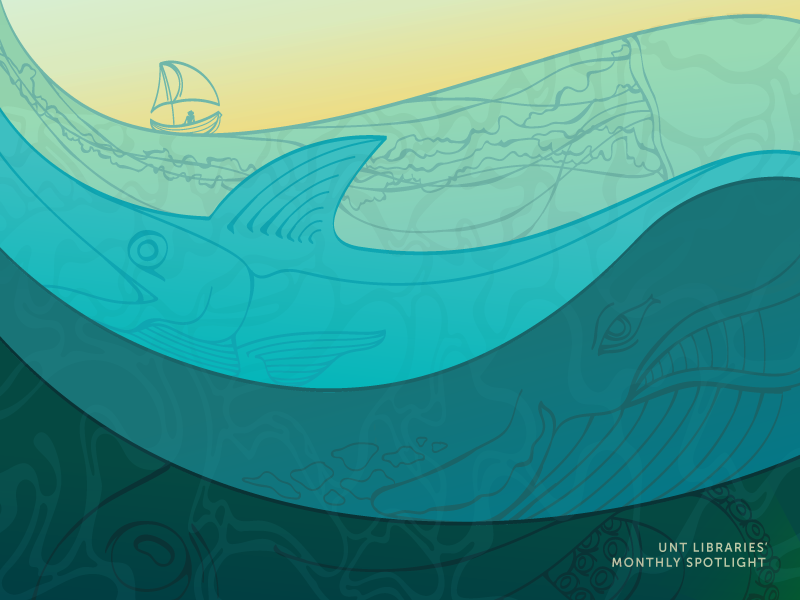
Monthly Spotlight: Our World Oceans
In a word: it’s too hot this summer. The best solution is to wade in a pool all day. Since we all have jobs or things to do, the next best solution is to talk about water long enough until you naturally cool off. Since World Ocean Day came and went in early June, we at UNT Libraries considered this a great time to dive into (get it?) our vast resources on the oceans around our little world. Surprisingly, we learned a few things about these massive seas that piqued our interest in mysterious legends, connected the dots to books we love and answered the most burning question of all: why is it so hot in D-FW? How the oceans affect you You might be wondering: why even worry about the oceans? After all, the nearest sea to us here in Denton – the Gulf of Mexico – is 330 miles away. And oceans? Pfft. The Atlantic coast is about 1,000 miles away and it’d take you 20 hours to drive to the Pacific coast. And yet, the oceans affect us every day. Specifically the Gulf Coast, which offers a streaming service that you might consider canceling every once and a while if you could The Gulf Stream is a rapid, strong ocean current that originates in the Gulf of Mexico and flows out into the Atlantic where it affects the weather from the United Kingdom on down to West Africa. Ireland and England should be much colder than they are, but our little Gulf of Mexico makes them quite habitable! And, as you can imagine, our close proximity to it keeps Texas pretty warm as well. Unfortunately, it also makes living here a little dangerous. NASA points out that tropical cyclones (i.e., hurricanes) “are like giant engines that use warm, moist air for fuel.” So that nice little pocket of warm, damp air in the Gulf that essentially makes much of Northern Europe a nice place to live? It also serves as a death engine for us living here next to it. Fantastic. One might think moving north, away from the ocean, keeps us safer. Well … not exactly. The Dallas-Fort Worth metroplex we call home rests in “Tornado Alley,” which exists because of the Gulf of Mexico hundreds of miles to the south. This graphic does an excellent job explaining why we’re in such a pressure-cooker: That massive sea to the south of us sends massive amounts of humid air north, which would be fine if our Canadian friends didn’t send cold winds south at the same time during the winter. When these two winds collide, they create thunderstorms. And it just so happens the D-FW area is right in the crossfire. So next Spring, when thunderstorms bring a local tree down on a power line and you’re stuck without Facebook for a few hours, make sure to shake your fist southward at the sea. Hate the weather here? Blame the sea. Or read more about the sea’s effects here at UNT Libraries, whether it’s Dudley Lynch’s excellent collection of Texas tornado stories or Erik Larson’s acclaimed book about the man who failed to prevent the deadliest hurricane in American history in Galveston If you were wondering, the National Weather Service predicts a “near-normal season” is the most likely scenario as hurricane season (which began in June) continues through November. They also mention “considerable uncertainty” about a weak El Nino this year, so who knows. We’re all just pawns in Mother Nature’s game, right? Why the names? The Atlantic Ocean’s name, as you might expect, comes from Ancient Greece. The name refers to the Titan in Greek Mythology, Atlas, who held the heavens on his shoulders. The historian Herodotus referred to the ocean as Atlantis Thalassa (Sea of Atlantis) in 450 BC. The Pacific Ocean went by Mar del Sur (Sea of the South) when Spanish explorer Vasco Nunez de Balboa discovered it in 1513 but later took on the name “Pacific” when Ferdinand Magellan – pictured above, in fancy statue form at Cape Horn in Argentina – named it Pacifico (“peaceful”) during his famous circumnavigation in 1519. Because it surrounds the Arctic, the Arctic Ocean’s nomenclature is pretty obvious. But where does “Arctic” come from? You guessed it: the Greeks. Oxford Dictionaries explains: Arctic conceals its origins rather more successfully; it comes from the Greek arktos, meaning ‘bear’ – and also ‘Ursa Major’ and ‘pole star’. The connection between bear and star comes from the story in Greek mythology that the nymph Callisto was turned into a bear and placed as a constellation in the heavens by Zeus. On the other end of the sneaky origin spectrum, the Indian Ocean is named as such because it borders India. Ocean Mapping If you’re a history nerd like many of us here at UNT Libraries, then you’ve probably come across some really strange maps during your Wikipedia wormhole plummets. Reading about the European discovery of the New World is one thing, but sifting through the speculative maps they made is another adventure entirely. With such limited information about the Americas, whose existence was a new concept to cartographers that had previously believed the Atlantic Ocean stretched from Europe to Asia, it’s no wonder so many ocean maps from hundreds of years ago look wonky. UNT Libraries provides access to the David Rumsey Historical Map Collection, a database with over 67,000 maps created throughout world history. Many of them offer unique glimpses at the early guesswork involved with imagining the new scope of the Pacific and Atlantic Oceans. In 1529: Was the Pacific Ocean a diagonal mass slicing toward South America? In 1704: It turns out the answer is no, but surely the Atlantic Ocean is super-narrow between South America and Africa! Ironically map in 1709 entitled “A New And Correct Map Of The World” shows a gulf of water between California and North America, the Pacific Ocean twice as large as it is and the Indian Ocean as only slightly larger than the Gulf of Mexico. Hundreds of years ago, it was simply impossible for people to grasp just how large our world and its oceans actually was. We have more than a few books at UNT Libraries that document the surprisingly dramatic races to correctly map the oceans. Legends Ah, the fun part. We’ve talked so much about the real science and history behind our world oceans so far. It’s time to get down to some of our favorite myths surrounding them. And there are a ton, as you might expect: we’ve explored only five percent of the Earth’s oceans to this day. That leaves a lot of mysteries to be solved, and legends have popped up about the unknowable deeps throughout the ages. Some of the most famous of these involve islands! You’ve heard of Atlantis, the mythical great island society wiped out by a flood in one of Plato’s stories. UNT Libraries has plenty of resources on Atlantis that you can use to solve the mystery yourself! There’s also Avalon, the mythical island resting place of King Arthur and the Fortunate Isles in the Atlantic Ocean, where Greek heroes were said to be buried. Finally, there are the sea monsters that range from legends to actual reported sightings. (No, Moby Dick doesn’t count.) in_the_news
Posted:
06/11/2018
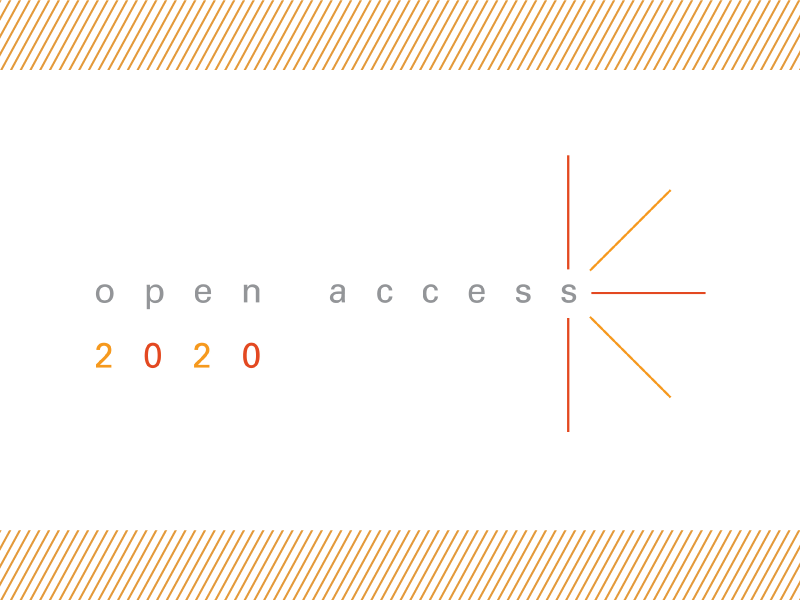
UNT Signs the OA2020 Expression of Interest
UNT is one of the first US universities to join a global alliance for accelerating the transition to open access scholarship. The University of North Texas has joined OA2020, a global alliance of institutions led by the Max Planck Digital Library in Munich, that have committed to taking active steps to drive the transformation of the system for publishing works of scholarship. By signing the OA2020 Expression of Interest, President Neal Smatresk has pledged that UNT will convert resources currently spent on journal subscriptions into support for sustainable models for publishing in open access, meaning articles are made free to read and share rather than available only through subscriptions. UNT is the seventh US institution and the first outside of California to sign the Expression of Interest. “With the cost of subscriptions to journals increasing by an average of 6% per year, libraries can no longer afford to continue absorbing the cost of subscribing to so many subscription-based journals,” said Diane Bruxvoort, dean of libraries. “As the primary customers for scholarly journals, academic libraries need to take leadership in converting academic publishing from a subscription model to one where other models of funding allow journals to be made free for all to read.” UNT has a longstanding commitment to open access. Since 2010 the UNT Libraries have organized an annual Open Access Symposium attracting speakers and attendees from around the world; the 2018 symposium will be held June 6–7 at the UNT Health Science Center in Fort Worth. UNT was the first public institution in Texas to adopt an open access policy, by which UNT researchers are expected to make their work available unless constrained by their publisher. The UNT Libraries will develop a strategy in consultation with UNT faculty and other researchers for converting funds spent on journal subscriptions. The Libraries will hold town hall events in September to provide more information about OA2020 and consult with faculty on possible paths towards fulfilling UNT’s commitment. The UNT Libraries will continue to offer interlibrary loan services to assist UNT researchers in getting access to journal articles and other material not available through the UNT Libraries. In addition, the UNT Libraries provides a number of resources to help researchers at UNT understand open access and make their work more widely available. research_support_services_in_the_news_did_you_know
Posted:
06/06/2018
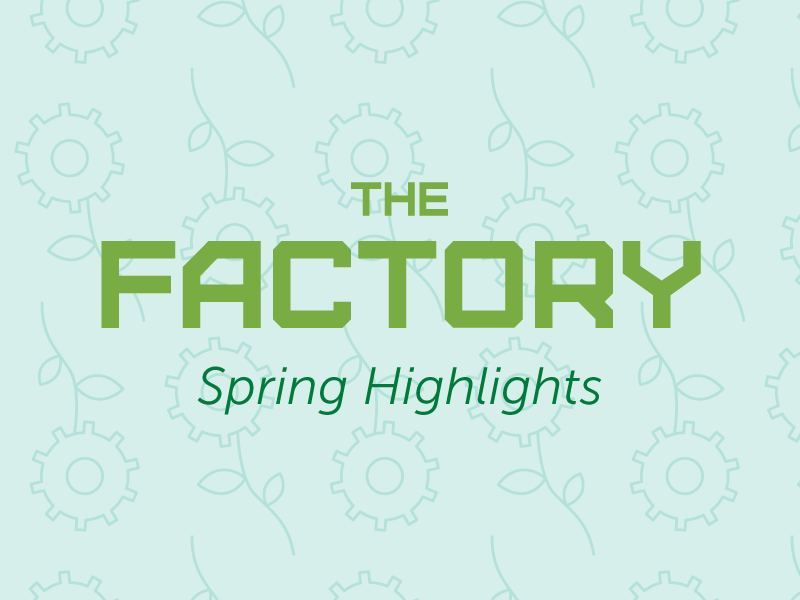
The Factory's Spring 2018 Highlights
It was a busy spring for our Makers at The Factory, as students and teachers from all walks of life made use of UNT Libraries’ resources to complete projects or enhance their education. From award-winning designs to innovative teaching techniques, here are a few highlights from The Factory’s spring 2018 semester. Asia Montague, a UNT Student in the College of Visual Arts & Design, dropped by The Factory this semester needing to laser-cut a large number of silk flowers for a dress she was designing for the 2018 Fashion Group International (FGI) Scholarship Competition. The theme was The Future of Fashion, and appropriately The Factory’s full spectrum laser cutter came in handy for her design. Maker techs in The Factory helped Asia cut each flower, made of many different colors of silk, which she then layered onto the flowers of the dress. With The Factory’s assistance and her terrific design, Asia won Best of Sewing at the show and the Paris American Academy Couture Award, which will let Asia study at the Paris American Academy this summer. (Photo credit: FGI Scholarship Competition on Facebook) During UNT’s 2018 Earthfest, professor Sophia Johnson of the Department of Biological Sciences asked her environmental science class to visit The Factory’s booth to get a sense of the Earth-friendly items The Factory can build. The Factory showed off bamboo flower pots made in the shape of Willis Library and the iconic Hurley Administration Building. The Maker Techs 3D printed the pots in bamboo because it is one of the world’s most renewable resources, able to be re-harvested every three years without ever harming the environment. The booth also presented their self-watering planters and a greenhouse they had built in The Factory. Students were able to use electronic tools from The Factory to measure the contents of the soils for pH levels and other signs of health. Below are photos of the booth and some of the environment-friendly creations made at The Factory for Earthfest 2018. During a busy Spring 2018 semester, The Factory helped play a pivotal role in an education course with their expertise and iPad resources. Jo Monahan, embedded librarian for the College of Education, Dr. Lauren Eutsler, College of Education assistant professor, and Traci Pettet, College of Education teaching fellow, were interested in using The Factory's iPads to instruct their students on how to use apps to teach kindergarteners in class. The Factory’s Maker Techs loaded the educational apps onto the iPads and assisted with technological troubleshooting throughout the lesson. The students were asked for their assessments of the apps, best teaching practices and whether or not each app might be effective as an in-class exercise. During the Spring ‘18 semester, Immaculate Conception Catholic School students from Mr. Mitchell Borowski’s eighth-grade technology class visited The Factory for a class on robotics and virtual reality. Maker Devin led the lesson, assisted by Makers John-Paul, Alicia, and Jordan. The students were guided through the steps of making robotic cars from scratch with the technology available in The Factory and then broken up into small groups to complete the tasks. By all accounts, the students had a blast seeing the finished products come together. Then the students were led to the Media Library, where they learned how to use the HTC Vive virtual reality gear on-hand in The Factory. The students then used the headsets to explore 3D projections of the International Space Station and Vatican City. in_the_news
Posted:
06/05/2018

Rescuing Texas History Mini-Grant Call for Submissions
The Portal to Texas History has recently announced the call for submissions for its most recent round of the Rescuing Texas History program. The Portal to Texas History has recently announced the call for submissions for its most recent round of the Rescuing Texas History program. Rescuing Texas History 2018 is the eleventh year of the program, which has brought to light over 45,000 items from 225 partnerships. Since the beginning of the program there have been over 6 million uses of materials hosted on the Portal to Texas History that were received in response to past call for submissions. Each project selected will be provided with up to $1,000 of digitization services to libraries, archives, museums, historical societies, and other groups (including individuals) that house historical materials. All materials accepted will be scanned at UNT Libraries and hosted on The Portal to Texas History. Deadline for receipt of applications is August 6, 2018. For more information and to download the application, please visit Rescuing Texas History Mini-Grant. external_relations_in_the_news
Posted:
06/01/2018
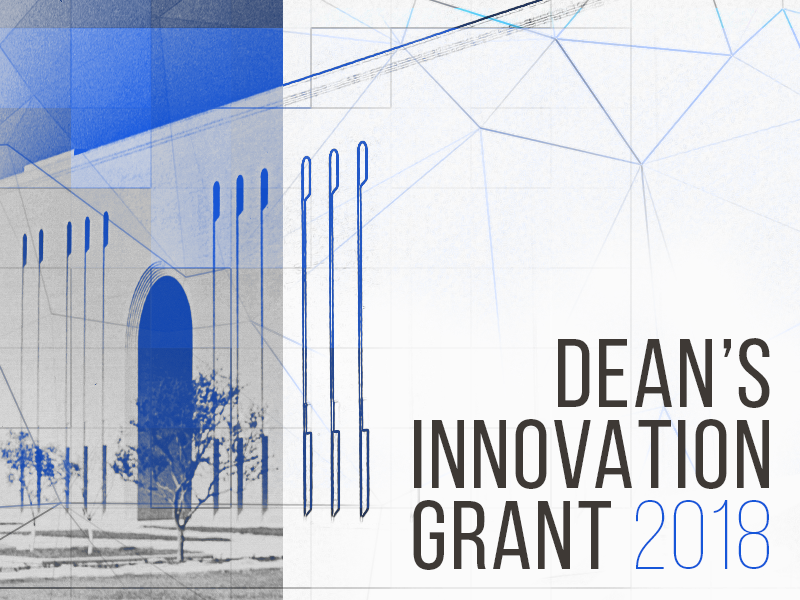
Dean's Innovation Grant 2018: Making Digital Collection A/V Materials Accessible
This project seeks to address accessibility compliance of A/V materials in the UNT digital collections. The University of North Texas Libraries’ Dean’s Innovation Grant, formerly known as the Green Light To Greatness Award, provides funding to research and projects within the UNT Libraries that promote scholarship and contribute to the gathering of knowledge that helps improve our libraries, our university, and the community. Dean’s Innovation Grant 2018 Awardee Will Hicks Project Title Making Digital Collection A/V Materials Accessible Project Description This project seeks to address accessibility compliance of A/V materials in the UNT digital collections. It reviews and documents relevant laws, technical standards, and best practices with regards to A/V content, allows for the creation of accessible alternatives for a test set of items currently available in the digital collections using both in-house and outsourced means, and evaluates content delivery methods using existing technical infrastructure. administrative_office_in_the_news_honors_and_awards_dean_s_innovation_grant
Posted:
05/30/2018
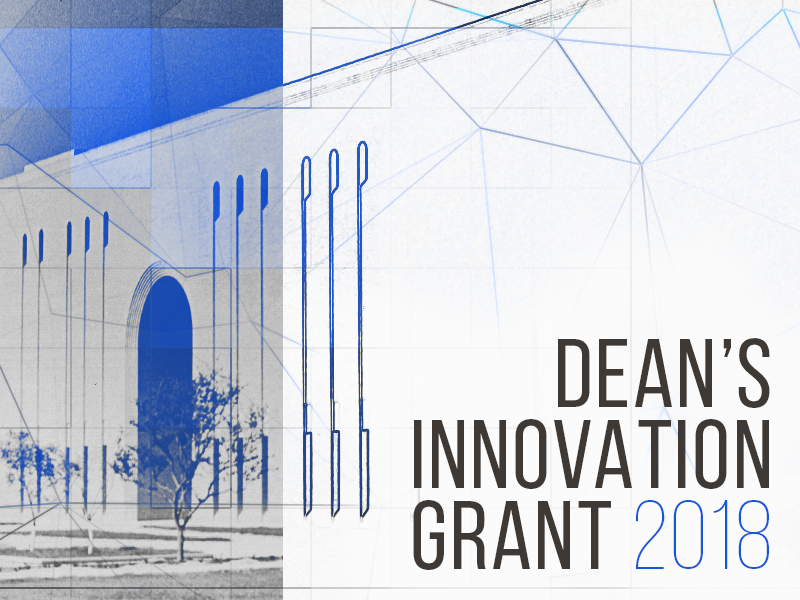
Dean's Innovation Grant 2018: Improving Library Services for Patrons of all Abilities
This project is designed to increase awareness and mindfulness of the needs of patrons with disabilities and to improve services offered to accommodate those patrons. The University of North Texas Libraries’ Dean’s Innovation Grant, formerly known as the Green Light To Greatness Award, provides funding to research and projects within the UNT Libraries that promote scholarship and contribute to the gathering of knowledge that helps improve our libraries, our university, and the community. Dean’s Innovation Grant 2018 Awardee Jennifer Rowe Project Title Improving Library Services for Patrons of all Abilities Project Description This project is designed to increase awareness and mindfulness of the needs of patrons with disabilities and to improve services offered to accommodate those patrons. Through a series of focus groups with UNT students and an online survey, the library will learn how to work with the unique needs of students with disabilities. administrative_office_in_the_news_honors_and_awards_dean_s_innovation_grant
Posted:
05/30/2018
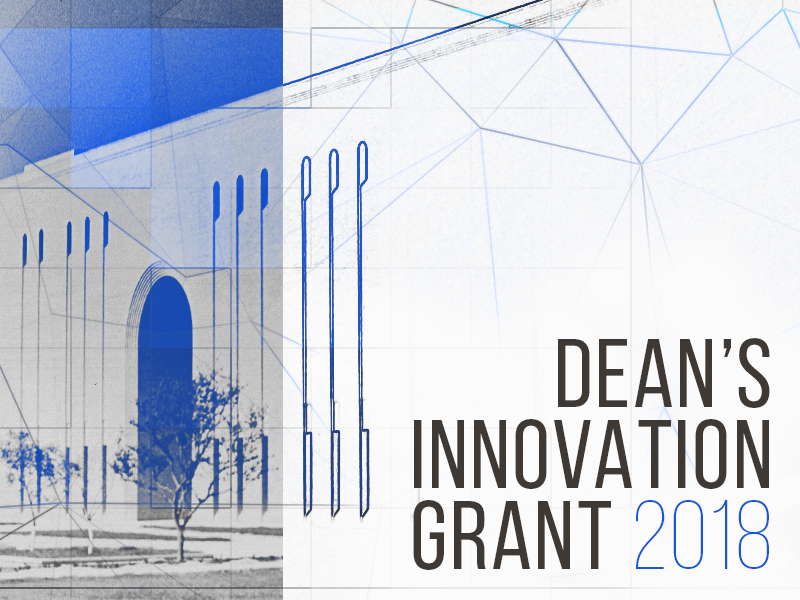
Dean's Innovation Grant 2018: MYS: Don't Fence Me In: Engaging Local Music Communities to Preserve Texas Music
The Local / Independent Music Initiative of Texas (LIMIT) is an ongoing initiative to collect, preserve, and provide access to music that originates from Texas. LIMIT team members have identified a desire in the Denton music community for an archiving project. The University of North Texas Libraries’ Dean’s Innovation Grant, formerly known as the Green Light To Greatness Award, provides funding to research and projects within the UNT Libraries that promote scholarship and contribute to the gathering of knowledge that helps improve our libraries, our university, and the community. Dean’s Innovation Grant 2018 Awardees Sara Outhier, David Huff, Justin Lemons Project Title Don’t Fence Me In: Engaging Local Music Communities to Preserve Texas Music Project Description The Local / Independent Music Initiative of Texas (LIMIT) is an ongoing initiative to collect, preserve, and provide access to music that originates from Texas. LIMIT team members have identified a desire in the Denton music community for an archiving project. UNT Libraries have the expertise and resources to preserve local music history by engaging with the stakeholders. Through outreach and programming, LIMIT team members will be an active presence in the local music community. administrative_office_in_the_news_honors_and_awards_dean_s_innovation_grant
Posted:
05/30/2018
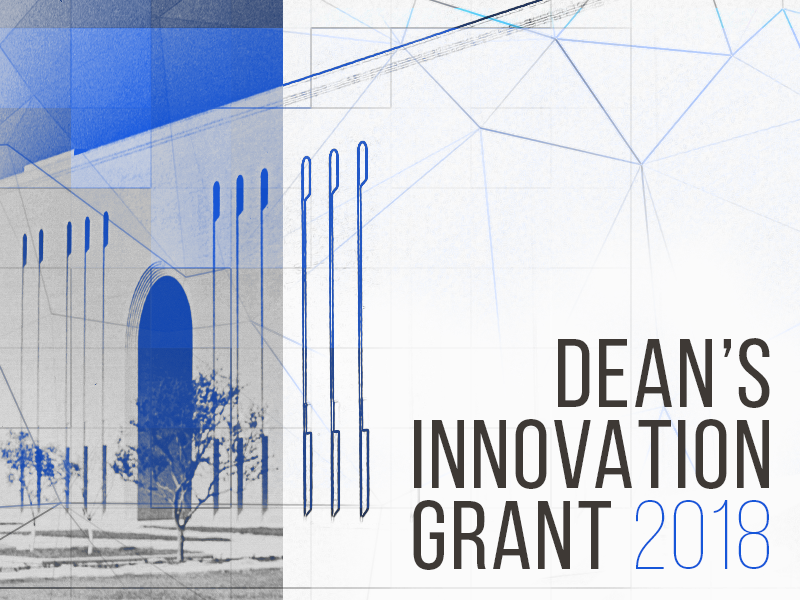
Dean's Innovation Grant 2018: MYS: Make-Your-Space
Through a series of focused classes, participants will design and create physical or digital objects to keep in their Factory show ‘case’. The University of North Texas Libraries’ Dean’s Innovation Grant, formerly known as the Green Light To Greatness Award, provides funding to research and projects within the UNT Libraries that promote scholarship and contribute to the gathering of knowledge that helps improve our libraries, our university, and the community. Dean’s Innovation Grant 2018 Awardee Judy Hunter Project Title MYS: Make-Your-Space Project Description Through a series of focused classes, participants will design and create physical or digital objects to keep in their Factory show ‘case’. The sessions will be a hands on immersion experience, taking the focus from learning about making to learning through making. Initially the project is planned to focus on subject Librarians. Librarians who participate will be equipped to share the experience to assist faculty in recognizing a greater connection to their curriculum, as well as students who can enhance their educational experience at UNT while building their resume. administrative_office_in_the_news_honors_and_awards_dean_s_innovation_grant
Posted:
05/30/2018
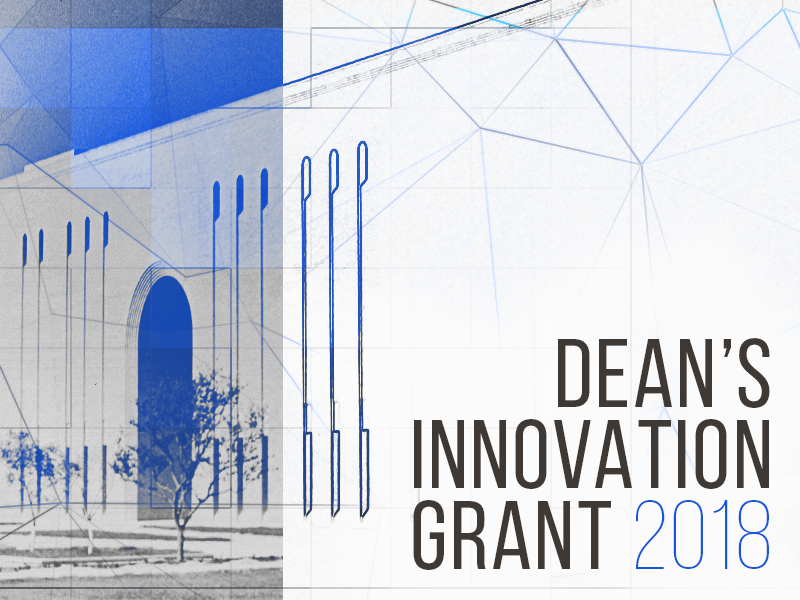
Dean's Innovation Grant 2018: Special Collections Podcast
This project is to launch a podcast dedicated to promoting and telling the stories of archival manuscript collections in UNT Special Collections The University of North Texas Libraries’ Dean’s Innovation Grant, formerly known as the Green Light To Greatness Award, provides funding to research and projects within the UNT Libraries that promote scholarship and contribute to the gathering of knowledge that helps improve our libraries, our university, and the community. Dean’s Innovation Grant 2018 Awardees Julie Judkins, Jaime Parker Project Title Special Collections Podcast Project Description This project is to launch a podcast dedicated to promoting and telling the stories of archival manuscript collections in UNT Special Collections to improve recognition of the UNT Libraries in the broader community, boost exhibit attendance and usage statistics in the UNT digital libraries, and encourage future licensing revenue. administrative_office_in_the_news_honors_and_awards_dean_s_innovation_grant
Posted:
05/30/2018
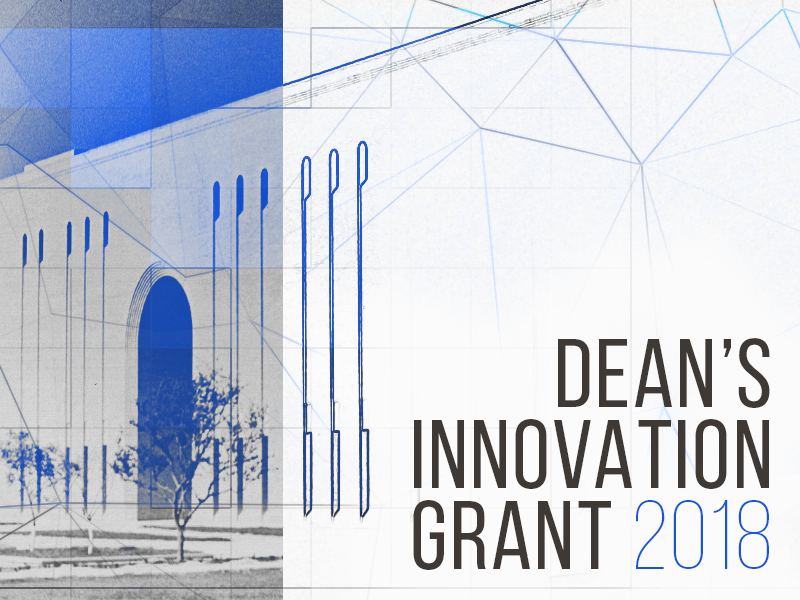
Dean's Innovation Grant 2018: Census of Game Collections in Libraries
In 2007, Dr. Scott Nicholson conducted a census of gaming to take a “pulse of the role of gaming in libraries.” In the decade since, both library game collections and game technologies have evolved. The University of North Texas Libraries’ Dean’s Innovation Grant, formerly known as the Green Light To Greatness Award, provides funding to research and projects within the UNT Libraries that promote scholarship and contribute to the gathering of knowledge that helps improve our libraries, our university, and the community. Dean’s Innovation Grant 2018 Awardees Diane Robson, Erin Miller Project Title Census of Game Collections in Libraries Project Description In 2007, Dr. Scott Nicholson conducted a census of gaming to take a “pulse of the role of gaming in libraries.” In the decade since, both library game collections and game technologies have evolved. A new census is needed to provide updated data that will be used to guide librarians as they continue to build game collections and services. administrative_office_in_the_news_honors_and_awards_dean_s_innovation_grant
Posted:
05/30/2018
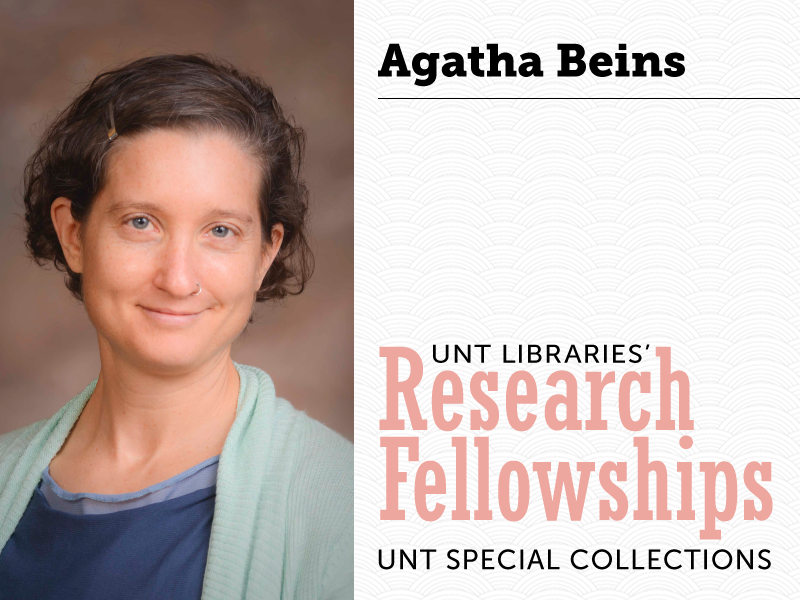
The UNT Special Collections 2018 Research Fellowship Awardee - Agatha Beins
Agatha Beins teaches in the Department of Multicultural Women’s and Gender Studies at Texas Woman’s University. Her book Liberation in Print: Feminist Periodicals and Social Movement Identity analyzes US feminist newsletters and newspapers published in the 1970s. In addition to her interest in feminist print cultures, she writes and teaches about the relationship between art and activism, feminist pedagogies, the institutionalization of women’s studies, and food studies. She also serves as editor for the online, open access journal Films for the Feminist Classroom. The University of North Texas Libraries invite applications for the 2018 UNT Special Collections Research Fellowship. Research in special collections is relevant to studies in a variety of disciplines including history, journalism, political science, geography, fine art, art history and American studies. We encourage applicants to think creatively about new uses for special collections. Preference will be given to applicants who demonstrate the greatest potential for publication and the best use of special collections at UNT Libraries. The UNT Special Collections 2018 Research Fellowship Awardee Agatha Beins Project Title An Invitation to Remember: Art, Activism and the AIDS Quilt Project Description The AIDS Quilt is over thirty years old, and I propose that it has been so effective and long-lasting because of its invitational approach to advocacy. I analyze the content and material qualities of the quilt to show the multiple paths it offered people to learn about HIV/AIDS and build community with those concerned about and impacted by the virus, and I draw on the activism in the Dallas/Ft Worth area as a case study to show the power of this art-activist project on a local scale. Biography Agatha Beins teaches in the Department of Multicultural Women’s and Gender Studies at Texas Woman’s University. Her book Liberation in Print: Feminist Periodicals and Social Movement Identity analyzes US feminist newsletters and newspapers published in the 1970s. In addition to her interest in feminist print cultures, she writes and teaches about the relationship between art and activism, feminist pedagogies, the institutionalization of women’s studies, and food studies. She also serves as editor for the online, open access journal Films for the Feminist Classroom. special_collections_in_the_news_honors_and_awards_research_fellowships
Posted:
05/29/2018
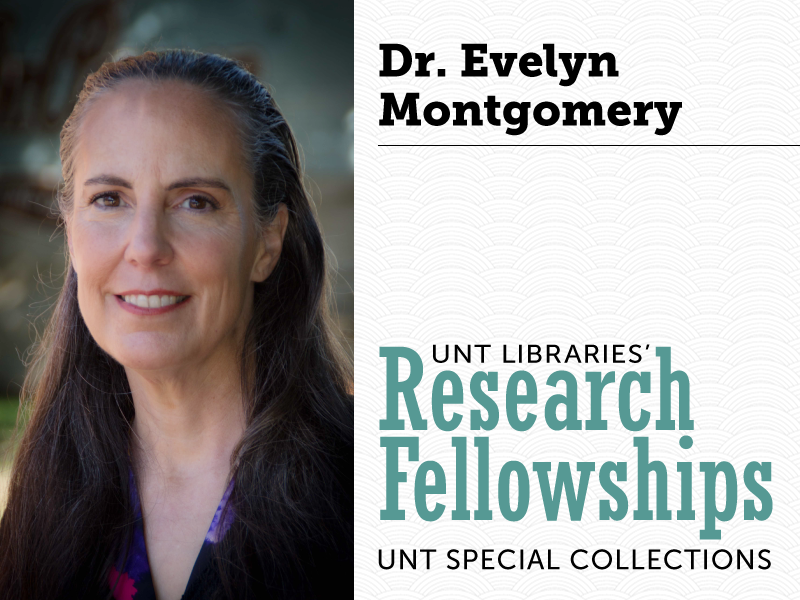
The UNT Special Collections 2018 Research Fellowship Awardee - Evelyn Montgomery
Dr. Evelyn Montgomery is the Director of Curatorial Affairs at Dallas Heritage Village, an outdoor museum that contains two of the cabins recorded by Dr. Jordan. She holds degrees in architecture and history, with a particular interest in American houses and domestic life, particularly for Victorians and on the frontier. She frequently presents on these subjects to both academic and popular audiences. She supports historic preservation through volunteer efforts, service on the Dallas Landmark Commission, and the maintenance and interpretation of the buildings of Dallas Heritage Village. The University of North Texas Libraries invite applications for the 2018 UNT Special Collections Research Fellowship. Research in special collections is relevant to studies in a variety of disciplines including history, journalism, political science, geography, fine art, art history and American studies. We encourage applicants to think creatively about new uses for special collections. Preference will be given to applicants who demonstrate the greatest potential for publication and the best use of special collections at UNT Libraries. The UNT Special Collections 2018 Research Fellowship Awardee Dr. Evelyn Montgomery Project Title House Proud in Texas: The Struggle For a Proper Frontier Home Project Description This project will mine the wealth of information available in the records of Texas log cabins collected by the late Dr. Terry G. Jordan, to see how Texas pioneers made their frontier cabins as homelike as possible. Pioneers were also Victorians, with high domestics standards for comfort and propriety. Texans need ingenuity and resourcefulness to make the materials at hand resemble their memories of fine homes back east, so they could be house-proud in their new state. Biography Dr. Evelyn Montgomery is the Director of Curatorial Affairs at Dallas Heritage Village, an outdoor museum that contains two of the cabins recorded by Dr. Jordan. She holds degrees in architecture and history, with a particular interest in American houses and domestic life, particularly for Victorians and on the frontier. She frequently presents on these subjects to both academic and popular audiences. She supports historic preservation through volunteer efforts, service on the Dallas Landmark Commission, and the maintenance and interpretation of the buildings of Dallas Heritage Village. special_collections_in_the_news_honors_and_awards_research_fellowships
Posted:
05/22/2018
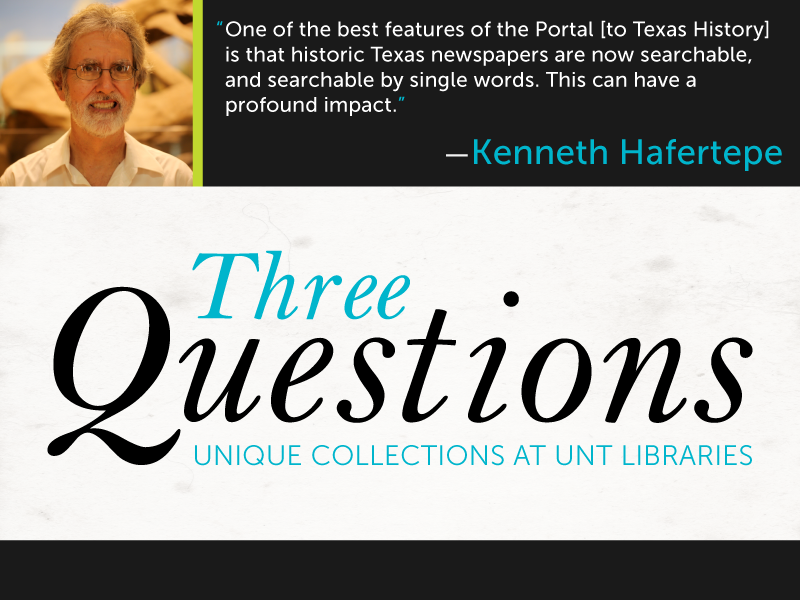
Three Questions with Kenneth Hafertepe
Dr. Kenneth Hafertepe grew up in Dallas, then attended Georgetown University in Washington, D.C. His graduate work was in American Civilization at the University of Texas at Austin. Since 2000, Dr. Hafertepe has taught in the Department of Museum Studies at Baylor University. He has written six books, co-edited two more, and has written many articles on American and Texan material culture. Three Questions is an initiative to share the value that our faculty, students, and others in the UNT community derive from using The Portal to Texas History at UNT Libraries. How important are Unique Collections in your teaching, learning or research? I have been doing research on Texas history for more than thirty years, and I am so glad to have a resource like the Portal to Texas History available to me. The Portal brings directly to my desktop resources that in earlier times would require many trips to archive and special collections libraries. It also makes available for the first time the records of museums and the Texas Historical Commission, including photographs that document the appearance of museum exhibitions and of historic buildings from the 1960s and 1970s, which are by no mean original but often provide evidence of what buildings looked like prior to restoration or remodeling. How have Unique Collections changed the way you approach your research, teaching or learning? One of the best features of the Portal is that historic Texas newspapers are now searchable, and searchable by single words. This can have a profound impact. I have been researching a “marble man” – that is, a gravestone carver – in Houston, by the name of T. F. Byrne. Before the Portal I would have looked for evidence of Byrne in Houston newspapers and perhaps Galveston; the Portal does a statewide search in a matter of seconds. In searching for Byrne the Portal led me to an article in a newspaper of San Marcos, describing a monument in the local cemetery made by Byrne in Houston. The monument is unsigned, and I would never have thought to read the San Marcos paper looking for a Houston stone carver, but the Portal led me right to it! What do you want others to know about your research, teaching or learning? My research is informed by the concept of material culture – that is, that the things people of the past left behind are an important source of historic evidence. When history is driven only by written documents – letters, diaries, newspaper, government documents – many people are left out of the story. Material culture also broadens the subject matter of history – from politics, religion, and intellectual life to the nature of everyday life, and to the many different forms of creativity. Dr. Kenneth Hafertepe grew up in Dallas, then attended Georgetown University in Washington, D.C. His graduate work was in American Civilization at the University of Texas at Austin. Since 2000, he has taught in the Department of Museum Studies at Baylor University. Dr. Hafertepe has written six books, co-edited two more, and has written many articles on American and Texan material culture. His most recent book, The Material Culture of German Texans, has won awards from the Texas State Historical Association, the Victorian Society in America, the Southeast Society of Architectural Historians, and the Philosophical Society of Texas. He was recently named a Fellow of the Texas State Historical Association. external_relations_in_the_news_three_questions
Posted:
05/21/2018
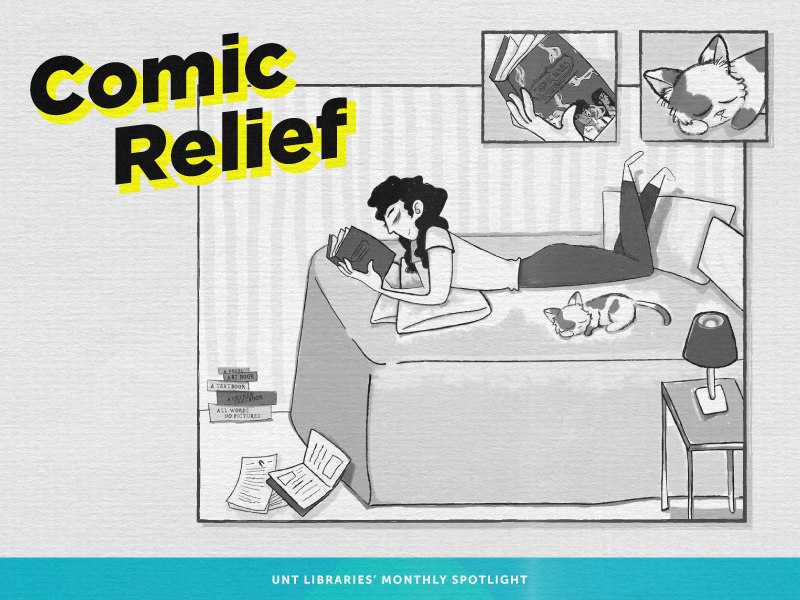
Monthly Spotlight: Comic Relief
It’s been a few weeks since “Avengers: Infinity War” hit theaters and you’ve either seen it five times or wish your friends would stop talking about it. That’s it. Those are the two kinds of people out there. We get it! Comic book movies aren’t for everyone. But the neat thing is that graphic novels, of which UNT Libraries is overflowing in, are for everyone. At the very least, the sheer variety of graphic novels on the Willis Library shelves ensures every student will find some colorful story to latch onto. Since May is usually the day Marvel takes over our pop culture lives with Free Comic Book Day and one or two major superhero films, we at UNT Libraries decided to let our dear visitors know just how many graphic novels we have available. Because we have a lot. From hidden gems to legendary series, there’s something in there that anyone can get lost in. We can’t think of a better way to unwind after the spring semester! But first, we have a debate to settle. What’s the difference between graphic novels and comic books? An important question! Because it kind of seems like “comic books” is a derogatory term sometimes, right? Many of our patrons have experienced this particular conversation: You: “Have you ever read [insert graphic novel title here]?” Former loved one: “Uh, no. Comic books are for kids.” You: *disowns them* Heartbreaking stuff, right? Comic books are not graphic novels. The two have always occupied different mediums with occasional line-blurring. But here’s a general difference: comic books are short, serialized stories told over a number of issues and a long period of time. Graphic novels are longer stories, with a clear beginning and end, more complex plots and one or two issues. Think of it this way: that Ultimate Spider-Man Annual #1, with every issue of Ultimate Spider-Man from 2005, is the graphic novel. The individual issues inside of it? Comic books. Now, onto the graphic novels! For History Buffs Yellow Rose of Texas: The Myth of Emily Morgan You know the tune if you grew up in the Lone Star State, but do you know about the woman at the heart of the myth behind the song? This graphic novel examines the myth-making African-American folk heroine, Emily Morgan, who allegedly aided the Texas revolutionaries at the Battle of San Jacinto. The Vietnam War: A Graphic History Ken Burns’ The Vietnam War docuseries was phenomenal when it debuted in 2017, but there’s no doubt a Ken Burns documentary series requires a time commitment. A Graphic History, on the other hand, gives you the best of both worlds: visual depictions of how the war played out in Vietnam and in the United States and a book you can read at your own leisure. Amelia Earhart: Free in the Skies Unfortunately one of the greatest American pilots of her time is best-known for her disappearance and not her record-breaking career beforehand. This graphic novel by Robert Burleigh and Bill Wylie serves as a biography of one of the most famous women in modern world history. For Fans of the Fantastical Science fiction has consistently found a home on the pages of graphic novels over the years. From giant men to alien life, here are a few reality-bending stories that have caught our eye. 3 Story: The Secret History of the Giant Man The life of Craig Pressgang, the titular giant man with an unruly growth hormone, is told by three women he grew close to as his increasing size left him isolated from the world he was out-growing. Akira The Japanese manga that inspired one of the greatest animated science fiction films of all time is ready to check out today. The plot about two paranormally-gifted teenagers fleeing agents in a futuristic and post-apocalyptic Tokyo almost single-handedly made mange popular outside of Japan when it debuted in 1982. The Wendy Project Take the tale of Peter Pan, place it in a modern setting from Wendy’s perspective and use it to tell a story of grief, family, and mental health and you get The Wendy Project. The official synopsis is intriguing, stating, “16-year-old Wendy Davies crashes her car into a lake on a late summer night in New England with her two younger brothers in the backseat. When she wakes up in the hospital, she is told that her youngest brother, Michael, is dead but she insists he is alive and in the custody of a mysterious flying boy.” For Superhero Fans We’re halfway through this Spotlight so this is as good a time as any to mention that oh, yes, we have plenty of Marvel and D.C. comics and graphic novels for you to enjoy. And most of them have recent movie adaptations that relate directly to them! Waiting impatiently for Deadpool 2 in a few weeks? Embrace more Wade Wilson wackiness with Deadpool Kills the Marvel Universe. Yes, your favorite wise-cracking, fourth-wall-breaking superhero actually assassinated all of your favorite Marvel heroes in 2012. The whole story is weirdly awesome. Speaking of, most of the big names – Spider-Man, The Avengers, Captain America, Hulk, Iron Man, Thor – from the Marvel Cinematic Universe sit on our bookshelves waiting to be checked out. For Biography Fans Biographies are stapled to the top of nearly every end-of-year bestsellers list. No matter the era, people like reading about other people. The connections made through text can be made just as easily through the imagery of graphic novels. Let these samplings from UNT Libraries prove it to you. The Complete Persepolis This is an illuminating coming-of-age story of Satrapi’s childhood and adolescence in the midst of the tumultuous Iranian Revolution. Her memories, relayed here in black-and-white, are both cuttingly funny and heartbreaking as she traces her life from childhood to self-imposed exile as an adult. My Degeneration: A Journey Through Parkinson’s Dunlap-Shohl was diagnosed with Parkinson ‘s disease at the age of 48 and has been an advocate for awareness of the malady ever since. “My Degeneration” traces the author’s journey through depression, the disease symptoms, the medication and its side effects, the author’s interactions with family, and the mental and physical changes caused by the disease. For A Fresh Take On An Old Favorite A novel becomes a classic for a reason: it simply contains terrific storytelling. And if we’ve learned anything from human history it’s that great storytelling travels across mediums So it’s no surprise a few legendary works of fiction have been reimagined as graphic novels over the last century. Here’s a handful available at UNT Libraries. The Invisible Man Adapted by Joeming Dunn and illustrated by Ben Dunn, this is an adaptation of H.G. Wells’ iconic novel about a scientist who achieves invisibility and falls prey to evil temptations. The Dark Tower While the film adaptation of one of Stephen King’s most famous works earned negative reviews last year, the comic series is generally well-received by critics and fans alike. That’s high marks for an adaptation of the magnum opus of one of America’s greatest authors. in_the_news
Posted:
05/14/2018
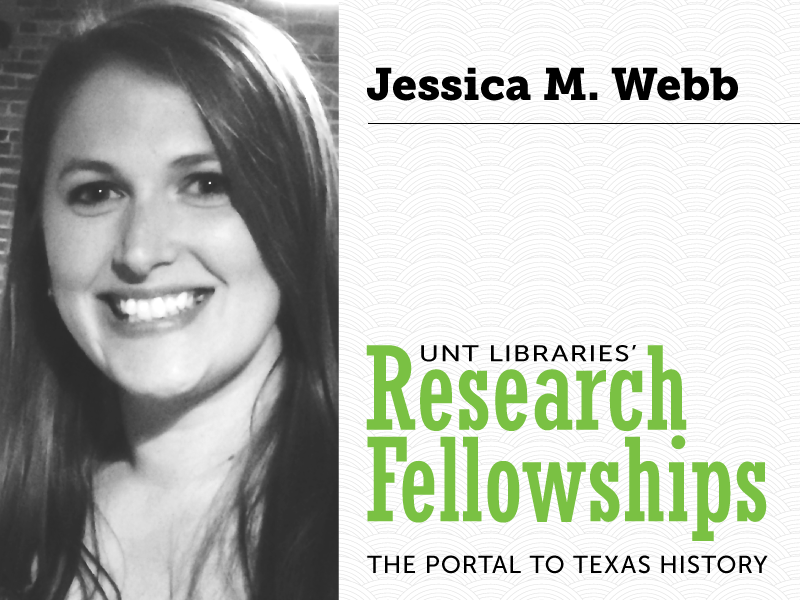
The Portal to Texas History 2018 Research Fellowship Awardee - Jessica Webb
Born and raised in the state of Texas, Jessica Webb received her Bachelor’s degree in History from Austin College in 2012. In 2014, she obtained her Master’s Degree in American History from TCU in Fort Worth and is working towards her Ph.D. there as well. Her research interests focus on the intersections of gender and sexuality and entrepreneurship within the framework of prostitution. She has been the recipient of several awards including the Boller Dissertation Fellowship and the Erwin E. Smith Research Fellowship. The University of North Texas Libraries invite applications for the 2017 The Portal to Texas History Research Fellowship. Research using the Portal is relevant to studies in a variety of disciplines including history, journalism, political science, geography, and American studies. We encourage applicants to think creatively about the opportunities that research with large digital library collections can enable. Preference will be given to applicants who demonstrate the greatest potential for publication and the best use of The Portal to Texas History. The Portal to Texas History 2018 Research Fellowship Awardee Jessica Webb Project Title Prostitution and Power in Progressive-Era Texas: Entrepreneurship and the Influence of Madams in Fort Worth and San Antonio, 1877-1920 Project Description “Prostitution and Power” examines the lives and careers of the women who owned and managed houses of prostitution, known as madams, in the red-light districts of Fort Worth and San Antonio. Moving from the latter decades of the nineteenth century up to the First World War, this project charts the expansion of prostitution, and the ability of these madams to obtain a substantial amount of social, political, and economic power, and the decline—of both the sex trade and its madams. Biography Born and raised in the state of Texas, Jessica Webb received her Bachelor’s degree in History from Austin College in 2012. In 2014, she obtained her Master’s Degree in American History from TCU in Fort Worth and is working towards her Ph.D. there as well. Her research interests focus on the intersections of gender and sexuality and entrepreneurship within the framework of prostitution. She has been the recipient of several awards including the Boller Dissertation Fellowship and the Erwin E. Smith Research Fellowship. digital_libraries_in_the_news_honors_and_awards_research_fellowships
Posted:
05/14/2018
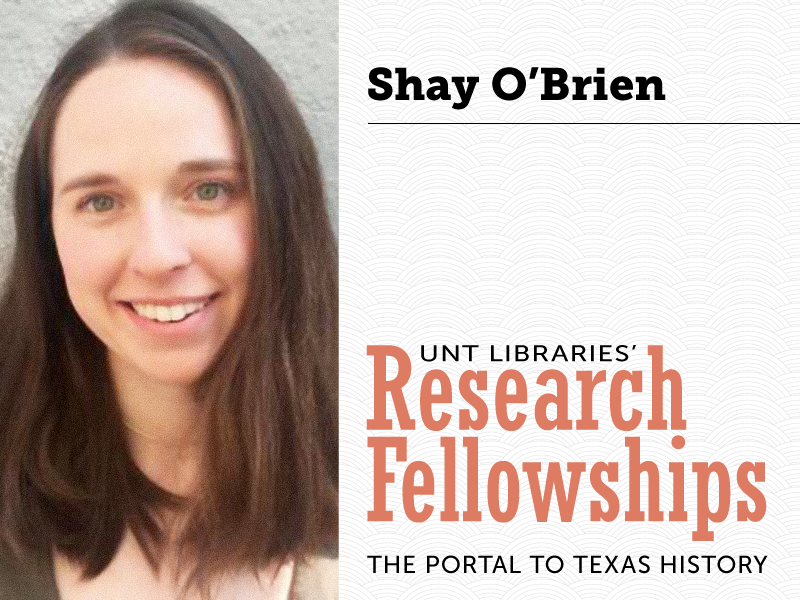
The Portal to Texas History 2018 Research Fellowship Awardee - Shay O'Brien
Shay O’Brien is a second-year Sociology student at Princeton studying elites and conservatives in the United States. Her areas of interest include economic sociology, elite sociology, race & ethnicity, and religion. Before beginning graduate school, Shay worked on a large-scale randomized control trial at the social policy research firm MDRC. She graduated from Brown University with a B.A. in Anthropology, where she was a research assistant in the Anthropology department and won the prizes for Best Honors Thesis and Highest Achievement in Linguistic Anthropology. The University of North Texas Libraries invite applications for the 2017 The Portal to Texas History Research Fellowship. Research using the Portal is relevant to studies in a variety of disciplines including history, journalism, political science, geography, and American studies. We encourage applicants to think creatively about the opportunities that research with large digital library collections can enable. Preference will be given to applicants who demonstrate the greatest potential for publication and the best use of The Portal to Texas History. The Portal to Texas History 2018 Research Fellowship Awardee Shay O’Brien Project Title Mapping Elite Social Networks in Dallas, 1896-1956 Project Description Using social registers supplemented by the Portal to Texas History and other archival sources, Ms. O’Brien is building a comprehensive longitudinal dataset of members of Dallas high society from 1896-1956. She is compiling information on each person’s basic biographical data, family relationships, close friendships, home addresses, and organizational memberships, such as churches and synagogues, workplaces, schools, and social clubs. When the dataset is complete, Ms. O’Brien will use it as the basis of numerous studies, beginning with one on the impact of the 1930 oil boom on the centers of Dallas sociopolitical power. Biography Shay O’Brien is a second-year Sociology student at Princeton studying elites and conservatives in the United States. Her areas of interest include economic sociology, elite sociology, race & ethnicity, and religion. Before beginning graduate school, Shay worked on a large-scale randomized control trial at the social policy research firm MDRC. She graduated from Brown University with a B.A. in Anthropology, where she was a research assistant in the Anthropology department and won the prizes for Best Honors Thesis and Highest Achievement in Linguistic Anthropology. digital_libraries_in_the_news_honors_and_awards_research_fellowships
Posted:
05/14/2018
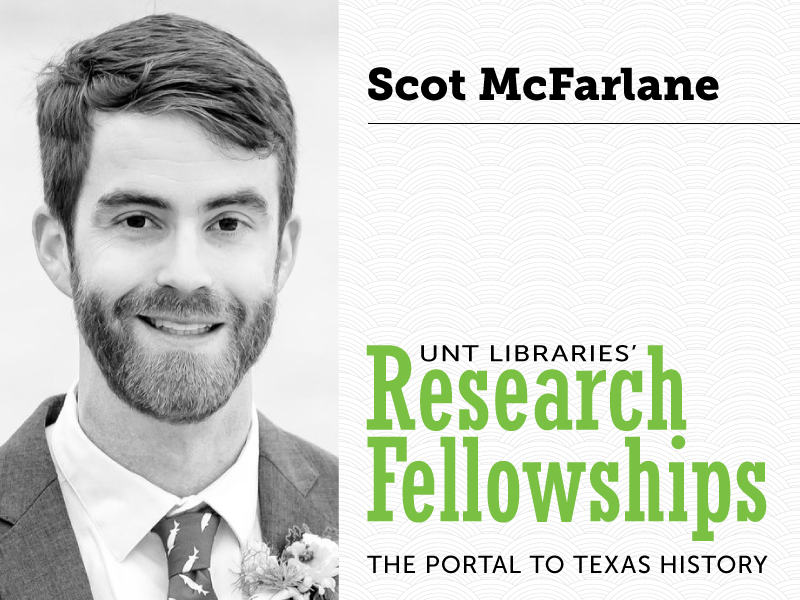
The Portal to Texas History 2018 Research Fellowship Awardee - Scot McFarlane
Scot McFarlane grew up in Concord, Massachusetts, and Palestine, Texas near the Trinity River. Currently a Ph.D. Candidate at Columbia University, his work has appeared in The Journal of Southern History and Environmental History. At Columbia, Scot has helped teach Mexican History, the History of the South, the History of New York, and is currently drafting a syllabus for a seminar on the history of rivers in North America. Prior to moving to NYC, Scot taught writing and history at high schools in the Willamette River Valley of Oregon. You can follow his research on his blog. The University of North Texas Libraries invite applications for the 2017 The Portal to Texas History Research Fellowship. Research using the Portal is relevant to studies in a variety of disciplines including history, journalism, political science, geography, and American studies. We encourage applicants to think creatively about the opportunities that research with large digital library collections can enable. Preference will be given to applicants who demonstrate the greatest potential for publication and the best use of The Portal to Texas History. The Portal to Texas History 2018 Research Fellowship Awardee Scot McFarlane Project Title The City and the Countryside on Texas’ Trinity River Project Description This project uses the history of the Trinity River to explore Texas’s ongoing transition from a rural to an urban state. While the pollution from North Texas always flowed down the Trinity into East Texas, politics and patronage meant both regions depended on each other. Furthermore, the power of the flooding Trinity River helped people resist the elite’s attempts to control their lives from within and beyond East Texas. Biography Scot McFarlane grew up in Concord, Massachusetts, and Palestine, Texas near the Trinity River. Currently a Ph.D. Candidate at Columbia University, his work has appeared in The Journal of Southern History and Environmental History. At Columbia, Scot has helped teach Mexican History, the History of the South, the History of New York, and is currently drafting a syllabus for a seminar on the history of rivers in North America. Prior to moving to NYC, Scot taught writing and history at high schools in the Willamette River Valley of Oregon. You can follow his research on his blog. digital_libraries_in_the_news_honors_and_awards_research_fellowships
Posted:
05/14/2018
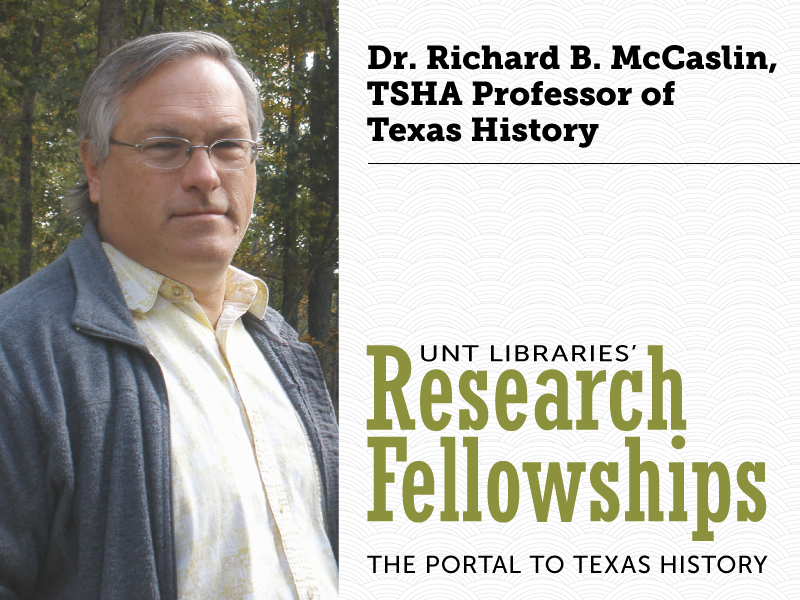
The Portal to Texas History 2018 Research Fellowship Awardee - Richard B. McCaslin
Richard B. McCaslin, TSHA Endowed Professor of Texas History at the University of North Texas, is the author or editor of eighteen books. One of the best known is Tainted Breeze: The Great Hanging at Gainesville, Texas, October 1862, which won the Tullis Prize and an AASLH commendation. He also wrote Lee in the Shadow of Washington, which received the Laney Prize and the Slatten Award, and was nominated for a Pulitzer. Another book, At the Heart of Texas: One Hundred Years of the Texas State Historical Association, 1897-1997, earned the Award of Merit from the Texas Philosophical Society. Yet another, Fighting Stock: John S. “Rip” Ford in Texas, received the Pate Award and Bates Award. The University of North Texas Libraries invite applications for the 2017 The Portal to Texas History Research Fellowship. Research using the Portal is relevant to studies in a variety of disciplines including history, journalism, political science, geography, and American studies. We encourage applicants to think creatively about the opportunities that research with large digital library collections can enable. Preference will be given to applicants who demonstrate the greatest potential for publication and the best use of The Portal to Texas History. The Portal to Texas History 2018 Research Fellowship Awardee Richard B. McCaslin Project Title Pompeo Coppini: Defining the Historical Landscape in Texas Project Description Pompeo Coppini, a classically trained sculptor from Italy, arrived in Texas at the onset of the Progressive Era, with its emphasis on such initiatives as the City Beautiful movement and historical tourism. Beginning in 1902, Coppini during more than five decades created dozens of iconic works in Texas focusing first on the Lost Cause, then the heritage of the Republic of Texas and the contributions of many local leaders. While his historical works also stand in many other states and several foreign countries, his greatest impact was in defining the historical landscape of Texas, or the imagery that shapes public perceptions of the past in the Lone Star State. Biography Richard B. McCaslin, TSHA Endowed Professor of Texas History at the University of North Texas, is the author or editor of eighteen books. One of the best known is Tainted Breeze: The Great Hanging at Gainesville, Texas, October 1862, which won the Tullis Prize and an AASLH commendation. He also wrote Lee in the Shadow of Washington, which received the Laney Prize and the Slatten Award, and was nominated for a Pulitzer. Another book, At the Heart of Texas: One Hundred Years of the Texas State Historical Association, 1897-1997, earned the Award of Merit from the Texas Philosophical Society. Yet another, Fighting Stock: John S. “Rip” Ford in Texas, received the Pate Award and Bates Award. digital_libraries_in_the_news_honors_and_awards_research_fellowships
Posted:
05/14/2018

The Portal to Texas History 2018 Research Fellowship Awardee - Kimberly Jackson
Kimberly Jackson is a master’s student and Teaching Assistant in the History Department at the University of North Texas. She earned a bachelor’s degree in history and mathematics at the University of North Texas. In the 2018-2019 academic school year, Kimberly will complete her thesis on the Civilian Conservation Corps in Big Bend National Park. Her larger academic interests include borderlands and environmental history and hopes to apply her research to larger studies of the U.S.-Mexico Border. The University of North Texas Libraries invite applications for the 2017 The Portal to Texas History Research Fellowship. Research using the Portal is relevant to studies in a variety of disciplines including history, journalism, political science, geography, and American studies. We encourage applicants to think creatively about the opportunities that research with large digital library collections can enable. Preference will be given to applicants who demonstrate the greatest potential for publication and the best use of The Portal to Texas History. The Portal to Texas History 2018 Research Fellowship Awardee Kimberly Jackson Project Title The Civilian Conservation Corps in Big Bend National Park Project Description Ms. Jackson’s project is a case study of the Civilian Conservation Corps (CCC) in Big Bend National Park. If it were not for the work of the CCC in Big Bend, the national park would not exist as we know it today. There does not currently exist a study on the CCC in Big Bend, and as such her research will help us to better understand the overall history and development of Big Bend. Biography Kimberly Jackson is a master’s student and Teaching Assistant in the History Department at the University of North Texas. She earned a bachelor’s degree in history and mathematics at the University of North Texas. In the 2018-2019 academic school year, Kimberly will complete her thesis on the Civilian Conservation Corps in Big Bend National Park. Her larger academic interests include borderlands and environmental history and hopes to apply her research to larger studies of the U.S.-Mexico Border. digital_libraries_in_the_news_honors_and_awards_research_fellowships
Posted:
05/14/2018

The Portal to Texas History 2018 Research Fellowship Awardee - Kenna Archer
Dr. Kenna Lang Archer is an instructor at Angelo State University in San Angelo, Texas, where she teaches U.S. environmental history, Texas history, and American history. Her first book, Unruly Waters, was published by University of New Mexico Press. She recently finished writing an updated edition of Ogallala: Water for a Dry Land with John Opie and Char Miller. She will be presenting her current research project at the Western History Association meeting in October. The University of North Texas Libraries invite applications for the 2017 The Portal to Texas History Research Fellowship. Research using the Portal is relevant to studies in a variety of disciplines including history, journalism, political science, geography, and American studies. We encourage applicants to think creatively about the opportunities that research with large digital library collections can enable. Preference will be given to applicants who demonstrate the greatest potential for publication and the best use of The Portal to Texas History. The Portal to Texas History 2018 Research Fellowship Awardee Kenna Archer Project Title Keeping Cool in Texas: A History Project Description The state of Texas is known for its highly variable weather and for the extraordinary heat that periodically roasts crops, accosts livestock, and challenges public morale. Keeping cool in this state has become both science and art, but efforts to beat the heat are nothing new. This project studies the long history of keeping cool in Texas from a social, environmental, and cultural perspective, paying special attention to the shifting relationship between technological dependence and climatological adaptation. Biography Dr. Kenna Lang Archer is an instructor at Angelo State University in San Angelo, Texas, where she teaches U.S. environmental history, Texas history, and American history. Her first book, Unruly Waters, was published by University of New Mexico Press. She recently finished writing an updated edition of Ogallala: Water for a Dry Land with John Opie and Char Miller. She will be presenting her current research project at the Western History Association meeting in October. digital_libraries_in_the_news_honors_and_awards_research_fellowships
Posted:
05/14/2018
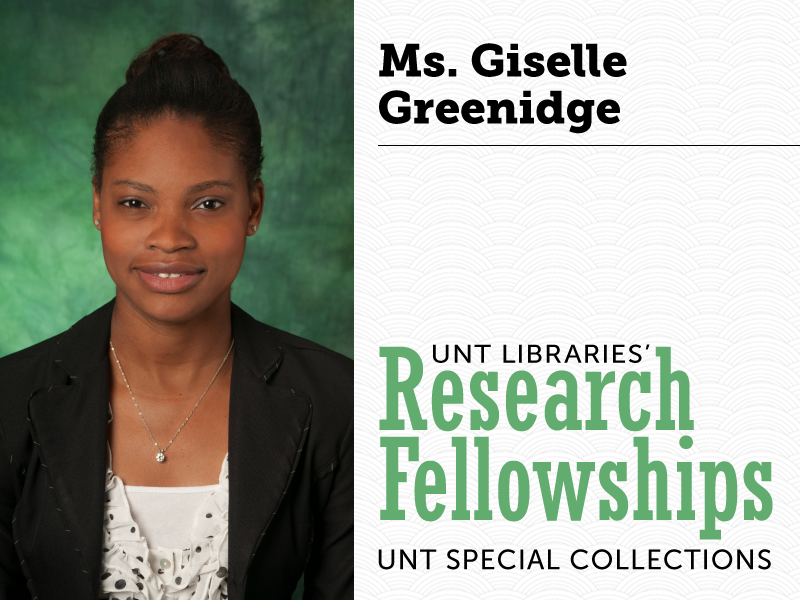
The UNT Special Collections 2018 Research Fellowship Awardee - Giselle Greenidge
Ms. Giselle Greenidge is a doctoral student in the Department of Sociology. Her major concentration is Global and Comparative Sociology and her minor concentration is Social Stratification. Ms. Greenidge is a teaching fellow at UNT, and her research interests include culture, globalization, and immigration. The University of North Texas Libraries invite applications for the 2018 UNT Special Collections Research Fellowship. Research in special collections is relevant to studies in a variety of disciplines including history, journalism, political science, geography, fine art, art history and American studies. We encourage applicants to think creatively about new uses for special collections. Preference will be given to applicants who demonstrate the greatest potential for publication and the best use of special collections at UNT Libraries. The UNT Special Collections 2018 Research Fellowship Awardee Giselle Greenidge Project Title African American and Caribbean Organizations in the DFW Metroplex Project Description Although there is a large number of Caribbean immigrants residing in Texas, their needs are often neglected, especially in the Dallas-Fort Worth area. This study will explore ways in which African American and Caribbean groups in D-FW can establish shared goals to serve the Caribbean community. Biography Ms. Giselle Greenidge is a doctoral student in the Department of Sociology. Her major concentration is Global and Comparative Sociology and her minor concentration is Social Stratification. Ms. Greenidge is a teaching fellow at UNT, and her research interests include culture, globalization, and immigration. special_collections_in_the_news_honors_and_awards_research_fellowships
Posted:
05/08/2018
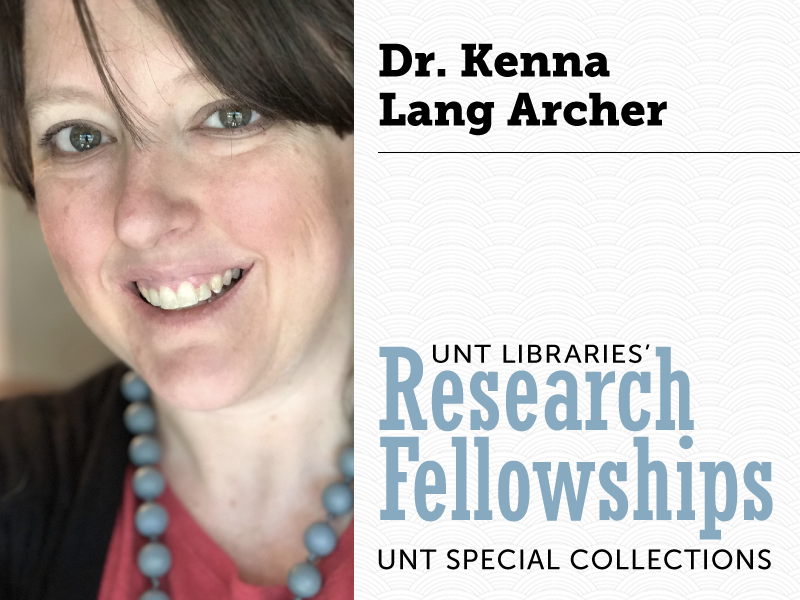
The UNT Special Collections 2018 Research Fellowship Awardee - Kenna Lang Archer
Dr. Kenna Lang Archer is an instructor at Angelo State University in San Angelo, Texas, where she teaches U.S. environmental history, Texas history and American history. Her first book, Unruly Waters, was published by University of New Mexico Press. She recently finished writing an updated edition of Ogallala: Water for a Dry Land with John Opie and Char Miller. She will be presenting her current research project at the Western History Association meeting in October. The University of North Texas Libraries invite applications for the 2018 UNT Special Collections Research Fellowship. Research in special collections is relevant to studies in a variety of disciplines including history, journalism, political science, geography, fine art, art history and American studies. We encourage applicants to think creatively about new uses for special collections. Preference will be given to applicants who demonstrate the greatest potential for publication and the best use of special collections at UNT Libraries. The UNT Special Collections 2018 Research Fellowship Awardee Kenna Lang Archer Project Title Mucking It Up: A History of Rivers, Politics, and Improvements in Texas Project Description The history of this state is inextricably tied into its waterways and into efforts to manipulate those waterways to meet the public’s perceived needs. This project examines the developmental history of state waterways and the governmental policy aimed towards improvement. Biography Dr. Kenna Lang Archer is an instructor at Angelo State University in San Angelo, Texas, where she teaches U.S. environmental history, Texas history, and American history. Her first book, Unruly Waters, was published by University of New Mexico Press. She recently finished writing an updated edition of Ogallala: Water for a Dry Land with John Opie and Char Miller. She will be presenting her current research project at the Western History Association meeting in October. special_collections_in_the_news_honors_and_awards_research_fellowships
Posted:
05/08/2018
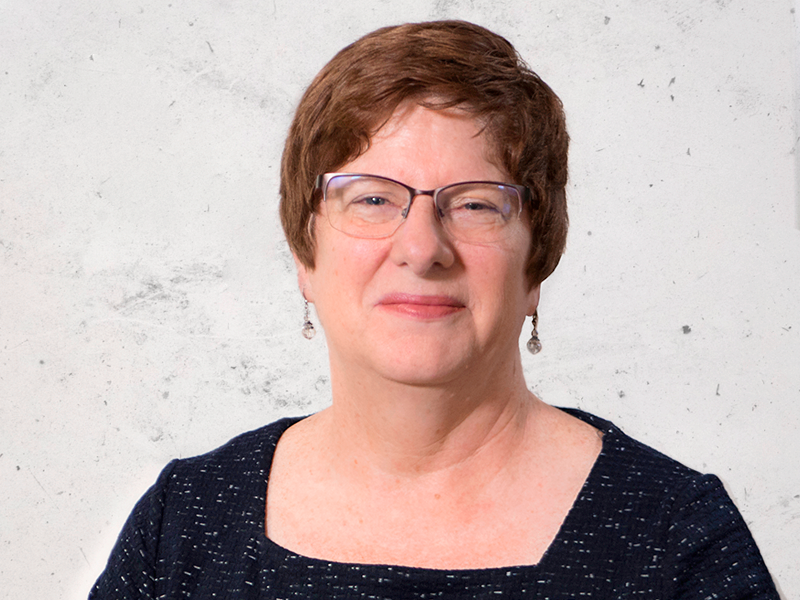
Welcome Diane Bruxvoort as Dean of UNT Libraries!
Diane Bruxvoort has joined us as Dean of Libraries. Diane Bruxvoort has joined us as Dean of Libraries. She was formerly the Libraries, Special Collections and Museums University Librarian and director at the University of Aberdeen in Scotland. In addition, she has worked at the University of Florida, the University of Houston, the Houston Public Library, the Harris County Public Library, and the Newberry Library – Chicago’s Independent Research Library. When asked what she would like to share with Library employees, Diane replied, “I am excited to be joining the team at the UNT. It might seem like quite a change from Aberdeen, Scotland, but academic libraries are much the same around the world, and have been my work home for many years now. I’m not new to Texas, having lived and worked in Austin and then Houston, and I’m finding that North Texas is much the same – great people who care about their work. I look forward to meeting each of you, and together setting strategic directions as to how we support our students and faculty in their learning and their research.” in_the_news
Posted:
04/17/2018
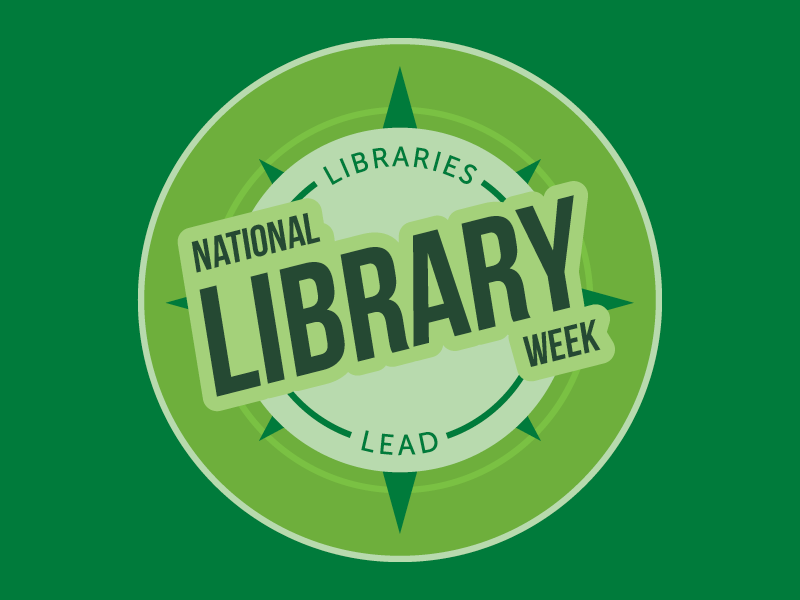
National Library Week 2018
This week, UNT Libraries joins libraries nationwide in celebrating the many ways libraries lead their communities through the transformative services, programs and expertise they offer. April 8-14 is National Library Week, an annual celebration of the life-changing work of libraries, librarians and library workers. Libraries aren’t just places to borrow books or study—they’re also creative and engaging community centers where people can collaborate using new technologies and develop their skills and passions. We’ve created an exciting lineup of events to celebrate the many ways our libraries lead the UNT campus and local community. Schedule of Events Edible Books Festival | Monday, April 9th, 1–3 pm | Willis Library 250H Help kick off National Library Week with us at the annual Edible Books Festival on Monday, April 9th in Willis Library! Members of the Denton community and UNT faculty, staff members, and students may enter their creations into the festival for free, and they are also invited to judge the entries and then eat them. Civic Engagement Tabling | Tuesday, April 10th, 12–3 pm | Willis Library Our Public Services division will have tables set out outside of Willis Library with resources about civic engagement, politics, and information literacy. Eagle Commons Library Birthday Celebration | Tuesday, April 10th, All Day | Eagle Commons Library (Sycamore Hall) Eagle Commons Library is turning 81 years old! Celebrate with the libraries at Eagle Commons all day long with cake and fun activities. Doc Spot: Starving the Beast | Wednesday, April 11th, 12 pm | Willis Library Forum, 140 Media Library will host the finale of this semester’s Doc Spot Film Series. As college tuition skyrockets and student debt explodes, a powerful new documentary reveals a nationwide fight for control of the heart, soul, and finances of America’s public universities. Japanese Book Making Workshop | Wednesday, April 11th, 2–5 pm | Willis Library Forum, 140 UNT Special Collections wanted to show that libraries lead in creativity, by offering a hands-on workshop to learn Japanese bookmaking techniques. This workshop will focus on the art of Japanese stab binding, the suminagashi paper marbling technique, and block printing. Please join us for this wonderful workshop, and leave with your own custom handmade book! The Human Library | Thursday, April 12th, 1–6 pm | Willis Library Forum, 140 UNT’s Human Library offers a safe and supportive space to help you learn from your fellow humans. Look through a catalog just as you would in a traditional library, select a ‘book’ that you are interested in, and sit down with the book to ‘read’ by having a conversation with the person representing the title. University Day Student Portraits Exhibit | Friday, April 13th, 11 am–1:30 pm | Library Mall UNT Special Collections curated this display of student portraits from the early 1900s through present day, showing the history of our student body, and the wonderful photography contained in the UNT Archives. This display should inspire students to look back at UNT history, as well as consider their own place within it. external_relations_about_the_libraries
Posted:
04/03/2018
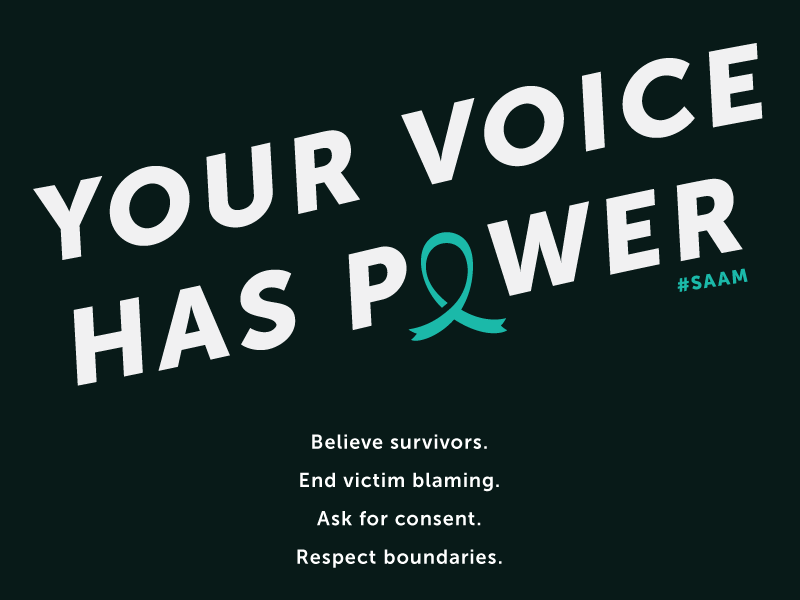
Sexual Assault Awareness Month
UNT and Denton County Friends of the Family are partnering together to support Sexual Assault Awareness Month by hosting a variety of educational events during the month of April. These programs provide opportunities for those passionate about advocating against sexual assault to stand in solidarity and educate the community. Some events this month include: Take Back the Night | Thursday, April 5 National Denim Day | Wednesday, April 25 Call to Action Program | All Month To view the complete calendar of events, please visit the UNT Survivor Advocates website. Here are resources available for anyone who has been impacted by sexual violence: UNT Student Survivor Advocate Denton County Friends of the Family National Sexual Assault Hotline Browse related resources in our library catalog. For questions about any of the events, please contact Renee McNamara at SurvivorAdvocate@unt.edu. public_services_in_the_news
Posted:
03/23/2018
Monthly Spotlight: Global Astronomy Month
The calendar has turned to April, another month has passed and our swiftly-moving home planet has moved another 47.94 million miles around the sun. During the next 47.94 million miles, Earth will be celebrating Global Astronomy Month as set by Astronomers Without Borders. In that starry spirit, we decided to spotlight the beautiful world of astronomy and how you can get involved right here in Denton, Texas. From star maps to stargazing parties to hotly-anticipated space travel events in 2018, here’s a handy guide to get you through Global Astronomy Month in style. (With plenty of links to relevant books from UNT Libraries, of course!) What is astronomy? Astronomy, according to the definition we just Googled, is “the branch of science that deals with celestial objects, space and the physical universe as a whole.” That sounds like a pretty huge branch. The neighboring branch is astrophysics, which deals with the actual mechanics (physics, motion, behavior, etc.) of those heavenly bodies. There are two fields of astronomy: observational (the direct study of celestial objects) and theoretical (modeling and analyzing how celestial systems evolve). The neat thing about astronomy is the barrier to entry, which doesn’t exist. Any of us can look up at the stars and practice observational astronomy. The key is knowing what you’re looking at and where to look. That’s where we come in! The UNT Sky Obviously, the sky is slightly different depending on where on Earth you’re standing and the time of year. Our planet, other planets, the stars and the galaxies that hold them … staring up at the universe is like staring out from a Tilt-A-Whirl ride at the fair, only at a slower speed and a grander scale. But pinpoint the exact date and location and you can figure out what you can look at and when to look for it. So here’s what you can look for from Denton’s streets around April 15, 2018. Looking to the South That thin blue line cutting across the middle of the sky is the galactic plane of the Milky Way. Yes, it’s visible from Earth! Raise your right arm out from your body, turn your head to look at it and you can get a decent idea of what you’re looking at when you see our galaxy from Earth, resting deep inside it. By the way: M42 is the Orion Nebula. Looking to the North You can see the galactic plane again here. In addition, there are a few notable star clusters and galaxies to pick out: M31 is the Andromeda Galaxy and M81 is Bode’s Nebula. Here’s a quick guide to viewing our solar system’s planets in April with links to star charts. Venus is difficult to observe from our city, [but it will become visible from about 7:48 p.m. to 8:44 p.m. just barely above the horizon][]. Neptune, Pluto, Mars, and Saturn are all visible in the night sky this month. [The best time to glimpse all of them in the same sky is around 5:30 a.m. while looking southeast.][] Jupiter rises to its highest visible point at 3:06 a.m., [where it will rest within the Libra constellation just above the ecliptic][]. Ceres, the lovable dwarf planet with the fascinating bright spots, is visible in Denton from 8:31 p.m. to 3:53 a.m. The best time to see it is at 10:32 p.m. when it rests smack-dab in the night sky. [Here’s a way to view it if you look west.][] Now you know where to look, but if you need some helpful guides make sure to check out these online books from UNT Libraries: Astronomy for Older Eyes: A Guide for Aging Backyard Astronomers by James L. Chen Astronomy of the Milky Way: The Observer’s Guide to the Northern Sky by Mike Inglis Astronomy Adventures and Vacations: How to Get the Most Out of Astronomy in Your Leisure Time by Timothy Treadwell Star Parties You may be surprised to learn just how many stargazing events go on around the Dallas-Fort Worth area every month. We live in a sprawling metroplex of lights and planes, but that doesn’t mean you can’t enjoy some amateur astronomy with friends and family around here. The Texas Astronomical Society hosts the Frisco Starfest each month at Frisco Commons Park. The next Starfest, on April 14, should be a big one as Global Astronomy Month continues. Our UNT friends in Cowtown won’t get left out, either: the Fort Worth Astronomical Society hosts a Tandy Hills Star Party each month as well over at the Tandy Hills Nature Area. If you really want to get outside of the D-FW light pollution, you can drive two hours and 120 miles away to Hubbard City Lakes Park, home of the famous Hubbard City Lakes Star Party. All of these events are free and provide telescopes and helpful guides to any visitors. You owe it to yourself to slow down, hit one of these star parties and take in the beauty that is our night sky. Just make sure to bring your copy of A Stargazing Program for Beginners: A Pocket Field Guide with you! Global Astronomy in 2018 The advent of the internet and live streams have made space mission launches must-see events each year. With some help from the New York Times, we’ve assembled a handful of the astronomical missions we’re most excited to read about in 2018. April 1: NASA launches the Grace-FO satellite The Gravity Recovery and Climate Experiment (GRACE) consisted of twin satellites, GRACE-1 and GRACE-2, that took measurements of anomalies in the Earth’s gravity field for over 15 years. They were decommissioned in October 2017, but the GRACE program will continue in April when GRACE-FO is launched. GRACE is an important part of climate science; the satellite tracks the movement of water and ice around the Earth. April: NASA launches the TESS spacecraft The Transiting Exoplanet Survey Satellite is designed to search for planets orbiting other stars throughout the Milky Way galaxy. It will replace the Kepler space telescope, which is in its final months of service. UNT Libraries has an online film snout the groundbreaking Kepler mission available to stream. Starting on April 22: Lyrids meteor shower will peak From the dusk of April 22 to dawn the next day, you can get a look at the annual Lyrids meteor shower. The Lyrids are the strongest annual shower of meteors in our night sky. The best time for Texans will be from 11:30 p.m. to 4:30 a.m. May: NASA launches the Mars InSight lander When InSight lands on the vast plain of Elysium Planitia, it will study Mars’ early geological evolution with an onboard seismometer and heat probe. Mars’ seismic activity is of interest in this mission to the Jet Propulsion Laboratory, which has been a key part of NASA’s journeys to Mars. June 1: Japan’s Hayabusa-2 will reach the asteroid Ryugu After 18 months of study, Hayabusa-2 will attempt to return to Earth with a surface sample from Ryugu in 2020. July 31: Parker Solar Probe launch NASA is sending this poor, doomed probe to within 4 million miles of the Sun’s surface, closer than any human spacecraft has come before. Parker will study the sun’s corona and solar wind. In the image above, the sun on the right is from Earth’s viewpoint. The sun on the left is how Parker will see it. #RIP. August 17: Osiris-Rex reaches Bennu Osiris-Rex was launched at the asteroid Bennu in 2016; like Hayabusa-2, NASA plans to have Osiris-Rex return an asteroid sample.by 2023. Books of Note The UNT Libraries collection of books on astronomy is vast; over 4,000 results come up through our online catalog. We encourage students and visitors to browse at their own leisure, but here are a few that piqued our own interest. We would be remiss if we didn’t start with Stephen Hawking’s A Brief History of Time. The late, transcendent scientist and black hole researcher set out in 1988 to make the field of astronomy and astrophysics easily accessible to the general public. He succeeded: Hawking’s book sold over 10 million copies in 20 years. Another can’t-miss staple of astronomical literature is Cosmos by Carl Sagan. It served initially as a companion piece to the Cosmos TV series, but it stands on its own as well. Galileo’s inventions may have revolutionized astronomy, but there was certainly Astronomy Before the Telescope. But this book on Galileo’s astronomy and the pushback by religion is still fascinating. in_the_news
Posted:
03/21/2018

Research Fellowships - Apply Now!
The University of North Texas Libraries invite applications annually for Research Fellowships in UNT Special Collections and The Portal to Texas History. The University of North Texas Libraries invite applications annually for Research Fellowships in UNT Special Collections and The Portal to Texas History. Research in our collections is relevant to studies in a variety of disciplines. Preference will be given to applicants who demonstrate the greatest potential for publication and the best use of our UNT Special Collections or The Portal to Texas History. Special Collections Research Fellowship The University of North Texas Libraries invite applications for the UNT Special Collections Research Fellowship. Research in special collections is relevant to studies in a variety of disciplines including history, journalism, political science, geography, fine art, art history and American studies. We encourage applicants to think creatively about new uses for special collections. Preference will be given to applicants who demonstrate the greatest potential for publication and the best use of special collections at UNT Libraries. The Portal to Texas History Research Fellowship The University of North Texas Libraries invite applications for The Portal to Texas History Research Fellowship. With relevant disciplines spanning from history and geography to filmmaking and photography, the Fellowship supports both scholarly research and creative output. We encourage applicants to envision the opportunities that working with large digital library collections can enable. Preference will be given to applicants who demonstrate the greatest potential for publication or exhibition and the best use of The Portal to Texas History. digital_libraries_in_the_news_honors_and_awards_about_the_libraries_collection_highlight
Posted:
01/19/2018
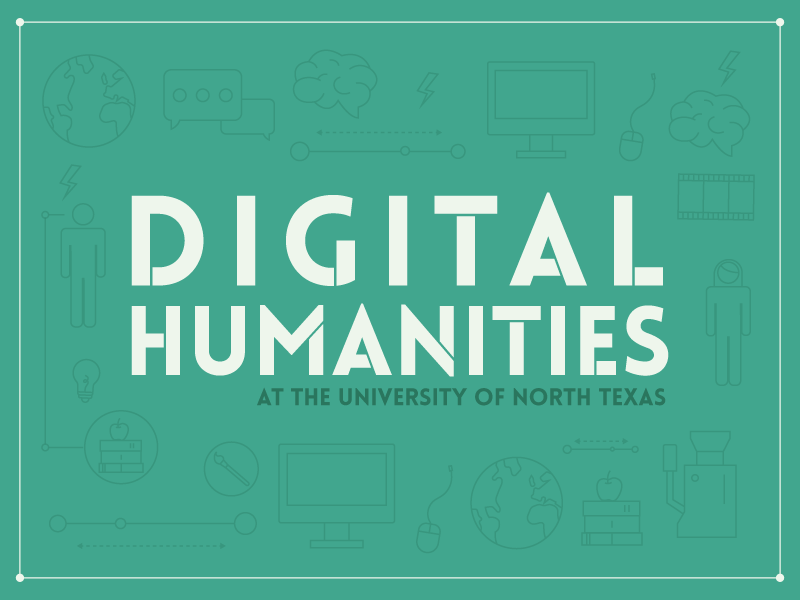
Help Celebrate the UNT Day of DH!
A Day in the Life of the Digital Humanities (Day of DH) is an international celebration of technology and the humanities. Join UNT librarians, faculty, staff, and students March 6, 2018 to learn about digital humanities concepts, projects, and tools. We define “digital humanities” broadly as any scholarly or creative activity that exploits the potential of digital media for humanities teaching, scholarly communication, or research. We welcome digital scholarship practitioners from any discipline to contribute. Class projects, early stage projects, critical inquiries, and theoretical interventions are also welcome. Help us build a great lineup of speakers, workshops, and collaborative events. All UNT faculty, staff and students are welcome to participate and propose sessions. Some ways you can contribute: Write a “Day in the Life” blog post or record a video describing a day in your life in digital humanities. Propose a hands-on workshop on a freely available tool for doing DH work. Propose a demo of a commercially available tool for doing DH work. Propose a workshop on digital pedagogy. Organize a panel of lightning talks highlighting different projects, strategies or ideas. Got other ideas? Tell us about them! Use this form to propose your contribution. Feel free to propose more than one (so if you do a workshop, you can also do a blog post about it, or anything else, too). Deadline for proposals is February 16, 2018. Questions? Please email digitalhumanities@unt.edu Blog and video posts will be shared on the DH @ UNT blog. You can also follow @DH_UNT on Twitter for relevant news and updates. Sponsored by the UNT Libraries Digital Humanities and Collaborative Programs Unit, the UNT Libraries Digital Scholarship Work Group, and Digital Frontiers. public_services_in_the_news
Posted:
01/19/2018
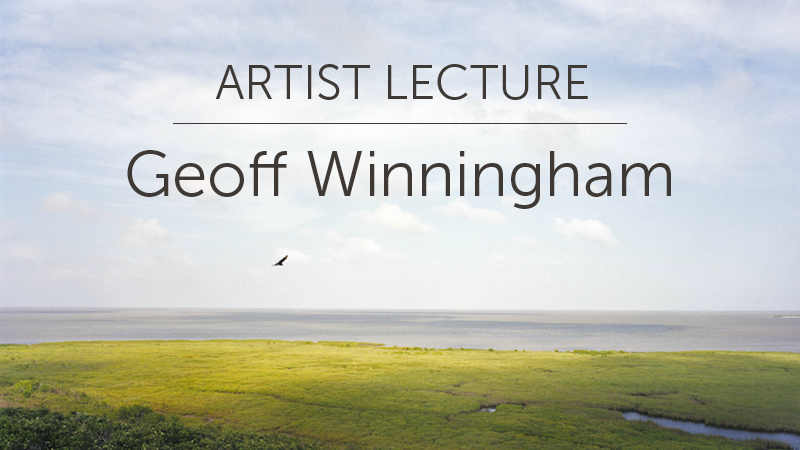
Artist Lecture: Geoff Winningham
Photographer Geoff Winningham will discuss his nationally-renowned, prize-winning photography. Photographer Geoff Winningham will discuss his nationally-renowned, prize-winning photography. Over a career that spans nearly 50 years, he has received two fellowships from the John Simon Guggenheim Foundation, five grants from the National Endowment for the Arts, and numerous commissions. He has published ten books and completed three documentary films on a wide variety of subjects, primarily related to Texas and Mexican culture. His book Traveling the Shore of the Spanish Sea: The Gulf Coast of Texas and Mexico (2010) won both the Ron Tyler Prize from the Texas State Historical Association and the J. B. Jackson Award from the Foundation for Landscape Studies. His photographs are in major collections across the United States, including the Museum of Modern Art and the Metropolitan Museum of Art, New York; the Boston Museum of Fine Arts; the Museum of Fine Arts, Houston; San Antonio Museum of Art; the Museum of Photographic Arts, San Diego; and the Wittliff Collections. This lecture is presented in collaboration with UNT’s College of Visual Arts and Design. digital_libraries_presentations_and_lectures
Posted:
01/18/2018

Books to Look Forward to in 2018
Last month we brought you some of 2017’s biggest reads courtesy of the Goodreads Choice Awards. With the calendar freshly turned to 2018, it’s time to look ahead at the page-turners we’re looking forward to in 2018. No doubt this list won’t cover all of the great books we’ll be talking about at the end of the year. The surprise hits are the best anyway, right? Debuts like The Hazel Wood by Melissa Albert, The House of Impossible Beauties by Joseph Cassara, Children of Blood and Bone by Tomi Adeyemi and Tangerine by Christine Mangan should make waves as the months roll along. But a few notable, experienced authors with works already available through UNT Libraries will hit shelves again in 2018. Here’s a handful of the ones we’re most excited to dive into, as well as links to other works you can check out right now. The Bomb Maker by Thomas Perry (Out Now) Perry has been a mainstay in the thriller genre for almost four decades now. His latest involves a bomb squad dispatched for disposal; the narrative purportedly spins into a tense, twisting yarn from there. UNT Libraries has the first five books of Perry’s acclaimed Jane Whitefield series, revolving around a Native American woman who helps desperate people disappear. The Largesse of the Sea Maiden by Denis Johnson (Jan. 16) The Largesse of the Sea Maiden is the final work of short stories published by Johnson, who died in 2017 of liver cancer. Johnson is one of the few authors to ever receive the Library of Congress Prize for American Fiction and was a finalist for the Pulitzer Prize for Fiction twice. Those two nominees, Tree of Smoke and Train Dreams, are both available through UNT Libraries. The Monk of Mokha by Dave Eggers (Jan. 23) You might know Eggers’ name from The Circle (adapted into a 2017 film starring Emma Watson and Tom Hanks) or his famous memoir A Heartbreaking Work of Staggering Genius. The Monk of Mokha will tell the true story of a Yemeni coffee farmer living through a civil war. An American Marriage by Tayari Jones (Feb. 6) Jones rose to prominence in 2002 with her coming-of-age story, Leaving Atlanta. A native of the Georgia city, Jones has set all three of her novels in her hometown. An American Marriage explores a modern marriage in the South while delving into the nation’s mass incarceration problems. Feel Free by Zadie Smith (Feb. 6) The 2017 recipient of the Langston Hughes Medal, this British author is widely revered as one of her generation’s greatest authors. Her debut novel, White Teeth, was an instant best-seller in 2000. Feel Free is her latest collection of essays, covering topics ranging from social media and her adoration for public libraries. White Houses by Amy Bloom (Feb. 13) White Houses features an interesting historical fiction premise: it’s a love story about Eleanor Roosevelt and White House journalist Lorena Hickok. Bloom previously wrote the short story collection Come to MeA Blind Man Can See How Much I Love YouAway. Sunburn by Laura Lippman (Feb. 20) Few 2018 books are as hotly anticipated as the latest from the detective author oWhat the Dead Know anI’d Know You Anywhere. Sunburn is described as modern noir about two lovers engaged in a dangerous game. House of Broken Angels by Luis Alberto Urrea (March 6) This timely novel about Mexican-American immigrants is scheduled for release right as the Deferred Action for Childhood Arrivals (DACA) program will expire under the Trump administration. Urrea was previously a finalist for the Pulitzer Prize for his book The Devil’s Highway. Varina by Charles Frazier (Apr. 17) Frazier is best-known for writing Cold Mountain, which won the 1997 National Book Award for Fiction and spawned a film adaptation that won numerous awards. Varina is about a woman helping her children escape from Jefferson Davis through a war-torn America during the Civil War.. God Save Texas by Lawrence Wright (Apr. 17) This book should interest a ton of visitors to UNT Libraries. Wright is a Dallasite and renowned nonfiction writer of The Looming Tower: Al-Qaeda and the Road to 9/11. Recently, his book Going Clear (a deep dive into the shady practices of Scientology) became an award-winning documentary. Wright came back home to write God Save Texas; he toured the state, devouring its history and culture to discover why it is a reflection of the country today. Barracoon by Zora Neale Hurston (May 8) Hurston was an influential contributor to African-American literature in the decades leading up to the civil rights movement. She died in 1960 before the movement truly took steam, but her legacy is undeniable. A major figure of the Harlem Renaissance, Hurston is best known for her 1937 book Their Eyes Were Watching God. Before she died, Hurston wrote a study on the last known survivor of the American slave trade. That story will finally be told when Barracoon hits shelves in 2018. Warlight by Michael Ondaatje (May 8) If you’ve ever seen “The English Patient,” this guy is the writer behind the novel that film was based on. Ondaatje is one of Canada’s greatest authors, and Warlight proves to be another great read. The novel centers around characters living in the post-World War II decade. Killing Commendatore by Haruki Murakami (November) Murakami is a best-selling author both inside and outside Japan. The author of Norwegian Wood, Kafka on the Shore and A Wild Sheep Chase returns this year with another bout of magical realism. Killing Commendatore will be a two-volume epic about a Japanese portrait artist. in_the_news
Posted:
01/04/2018